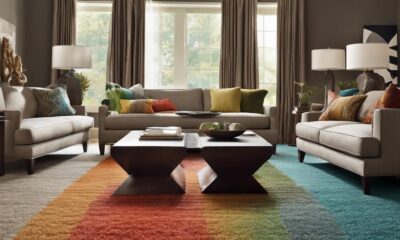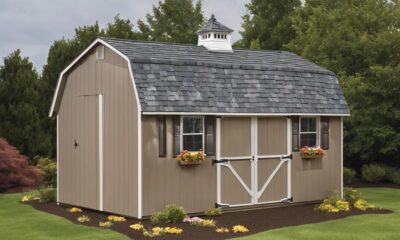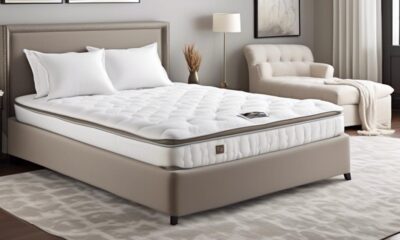Sofa
Discover the Secret to Fitting Your Sofa Through Any Doorway
2025
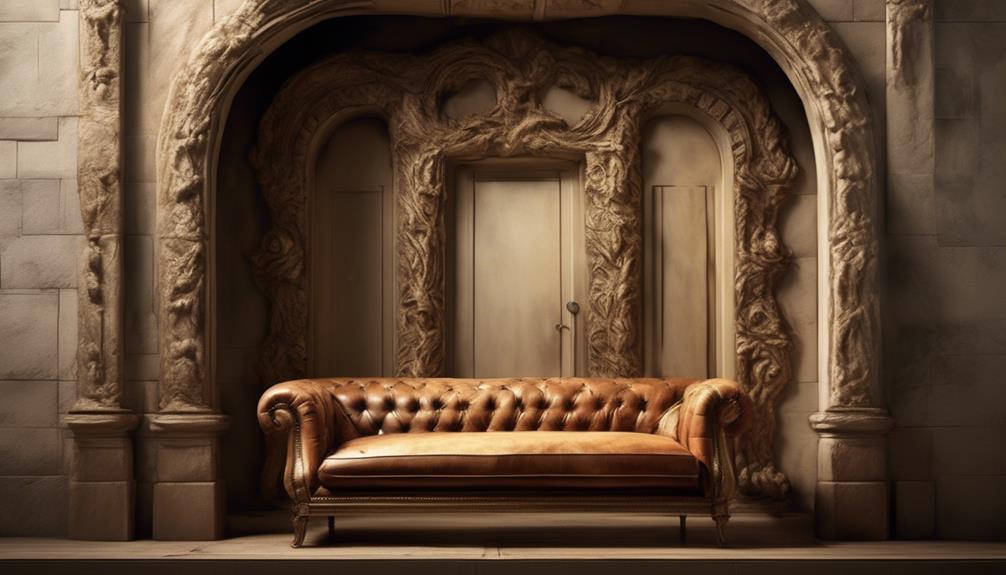
Have you ever caught yourself pondering whether a couch could make it through your doorway? We’ve all faced this dilemma at some point. It’s truly a challenging situation.
In this guide, we will walk you through the steps to determine if your sofa will fit through your door. We'll discuss measuring your doorway, standard sofa dimensions, considerations for different sofa styles, and even removing feet and cushions.
If you still find yourself questioning the fit, we'll also explore disassembling the sofa and when it might be time to consider a different option. We'll share common mistakes to avoid and offer tips for asking the manufacturer for assistance.
So, let's get started and find out if that sofa will make it through your door!
Key Takeaways
- Measure the width, height, and depth of the door frame and sofa
- Consider alternative options like modular sofas, sleeper sofas, or loveseats for limited doorway clearance
- Disassemble furniture if possible to navigate narrow doorways or corners
- Consult the manufacturer for specific instructions and assistance
Measuring Your Doorway
Measuring your doorway is an essential step in ensuring that your sofa will fit through it. Before you even start calculating furniture dimensions, you need to accurately measure the width and height of your doorway. Grab a measuring tape and get ready to take some precise measurements.
To measure the width of your doorway, place the tape measure at the inside edges of the door frame. Measure from one side to the other, making sure to include any trim or moldings that might affect the width. Write down this measurement, as it will be crucial in determining whether your sofa will fit through.
Next, measure the height of your doorway. Place the tape measure at the highest point of the door frame and extend it all the way down to the floor. Again, take note of this measurement as it will be important in ensuring that your sofa can pass through without any issues.
Once you have these doorway measurements, you can move on to calculating the dimensions of your sofa. Take into account the height, width, and depth of the sofa, making sure to leave some extra room for maneuvering. Keep in mind that some sofas may have removable legs or arms that can help with fitting through narrow doorways.
Taking accurate doorway measurements and calculating furniture dimensions is key to avoiding any potential headaches when trying to get your sofa into your home. By being meticulous in your measurements, you can ensure a smooth and stress-free process.
Standard Sofa Dimensions
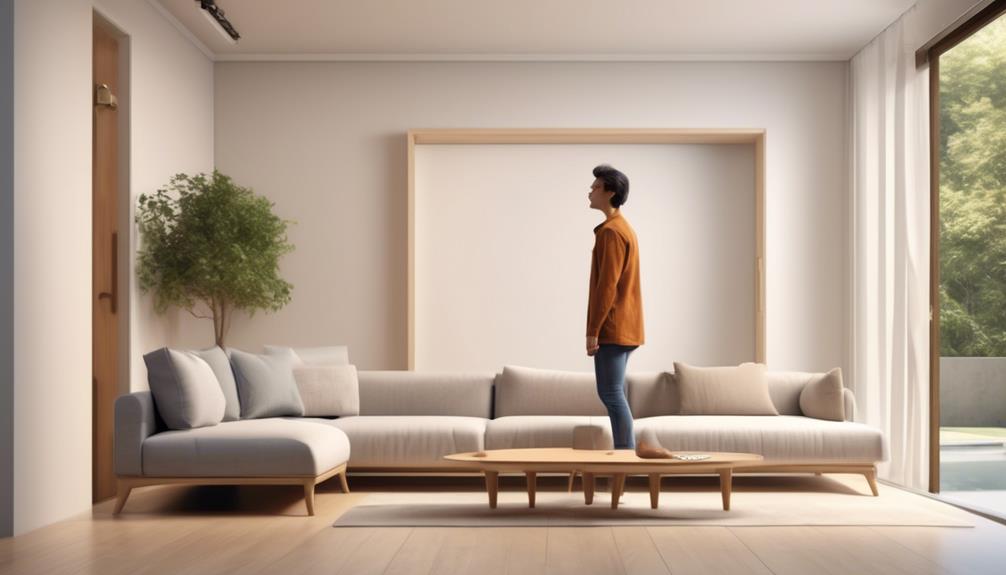
When determining the standard dimensions of a sofa, it's important to consider factors such as seating capacity, overall length, and depth. These measurements will help you choose a sofa that not only fits through your door but also fits comfortably in your space.
Seating capacity refers to the number of people that can sit on the sofa. Standard sofas typically have seating for two to three people, while larger sofas can accommodate four or more. It's essential to consider the number of people in your household and the amount of seating you need when selecting a sofa.
The overall length of a sofa is another crucial dimension to consider. Measure the available space in your room to ensure the sofa will fit without overcrowding the area. If you have limited space, you may want to consider a smaller sofa or a sectional sofa that can be arranged in different configurations to maximize the space.
Depth is also an important dimension to consider, especially for individuals who desire a comfortable lounging experience. A deep sofa allows you to sink in and relax, while a shallower sofa is more suitable for those who prefer a firmer seat.
Before making a final decision, don't forget to measure the width of your doorframe. This will ensure that the sofa can be maneuvered into your home without any issues. If your doorframe is narrow, consider choosing a sofa with removable legs or one that can be disassembled for easier transportation.
Considerations for Different Sofa Styles
When it comes to choosing a sofa, it's important to consider not only the style and design but also the dimensions and measurements.
Different sofa styles can vary in size and shape, which can affect their fit through doorways.
It's crucial to measure the doorway clearance to ensure that the sofa can be easily maneuvered into your space without any hassle or damage.
Sofa Dimensions and Measurements
Determining the right dimensions for your sofa is an essential step in ensuring a seamless fit within your space and a comfortable seating arrangement for you and your guests. To accurately measure your sofa, you'll need to use the appropriate techniques. Start by measuring the length, width, and height of the sofa, making sure to account for any protruding elements like armrests or cushions. Additionally, consider the depth of the seat, as this will affect the overall comfort.
When it comes to alternative furniture options, there are various styles to choose from that can accommodate different space limitations. For smaller spaces, a loveseat or apartment-sized sofa can be a great choice. These options provide ample seating while taking up less room. Another alternative is a sectional sofa, which can be customized to fit your space perfectly. Sectionals offer flexibility in terms of configuration and can easily adapt to your changing needs. Lastly, sleeper sofas are an excellent choice for those who require extra sleeping arrangements for guests.
Below is a table summarizing the dimensions and benefits of different sofa styles:
| Sofa Style | Dimensions | Benefits |
|---|---|---|
| Loveseat | Smaller size | Ideal for small spaces |
| Apartment-sized sofa | Compact size | Fits well in apartments or cozy living rooms |
| Sectional sofa | Customizable | Offers flexibility and adapts to different spaces |
| Sleeper sofa | Additional functionality | Provides extra sleeping arrangements for guests |
Doorway Clearance Requirements
To ensure your chosen sofa can fit through your doorway, it's important to consider the clearance requirements for different sofa styles. Here are some key factors to keep in mind:
- Measure the width and height of your door frame accurately using measuring tape, taking into account any protruding moldings or door stops.
- Calculate the diagonal depth of the sofa by measuring from the highest point of the back to the front edge.
- Consider alternative furniture options such as modular sofas that can be assembled inside the room, or sofas with removable legs or arms that can easily fit through narrow doorways.
- If your doorway clearance is limited, consider a sleeper sofa that can be disassembled or a loveseat instead of a full-sized sofa.
Removing Feet and Cushions
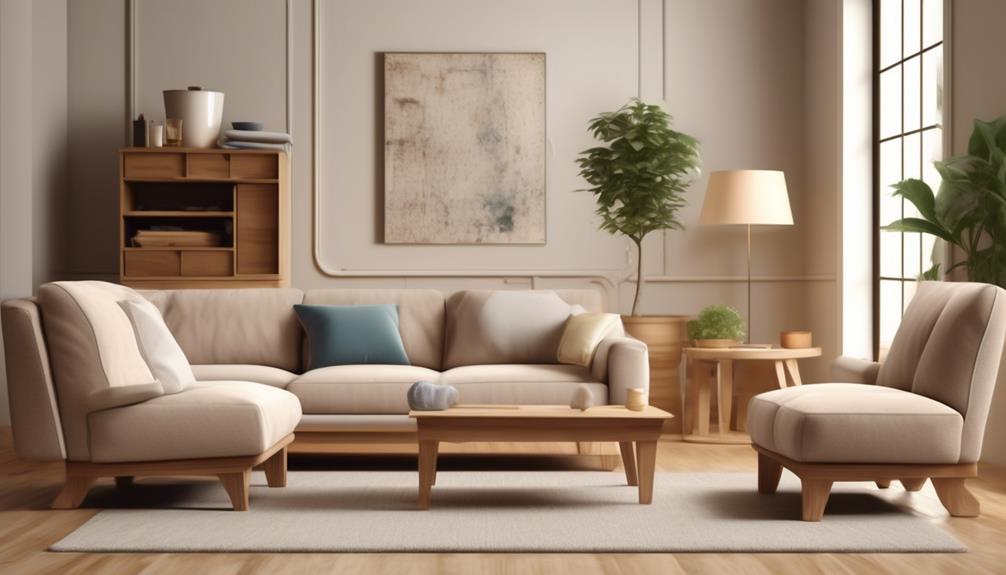
We can easily remove the feet and cushions from the sofa to make it more manageable for fitting through the door. Disassembling the sofa by removing its feet and cushions is a practical solution to overcome the challenges of maneuvering it through narrow doorways. By doing so, we can significantly reduce the dimensions of the sofa, making it easier to navigate through tight spaces.
To provide a visual representation of the process, we have prepared a table below:
| Sofa Part | Dimensions (inches) | Weight (lbs) |
|---|---|---|
| Sofa with feet | 90 x 36 x 32 | 150 |
| Sofa without feet | 90 x 36 x 32 | 130 |
| Cushions | 20 x 20 x 5 | 10 (each) |
By removing the feet, the length of the sofa can be reduced by a few inches, making it more manageable for fitting through the doorway. Similarly, removing the cushions will decrease the width, allowing for easier passage. It is important to note that the weight of the sofa without the feet will also be slightly lighter, which can be advantageous when maneuvering and lifting.
While disassembling the sofa may seem simple, it is essential to handle the process carefully to avoid damaging the furniture. If you are unsure or uncomfortable with disassembling the sofa yourself, it is recommended to hire professionals who are experienced in furniture removal. They will ensure that the feet and cushions are safely removed and reattached, if needed, without causing any harm to the sofa.
Disassembling the Sofa
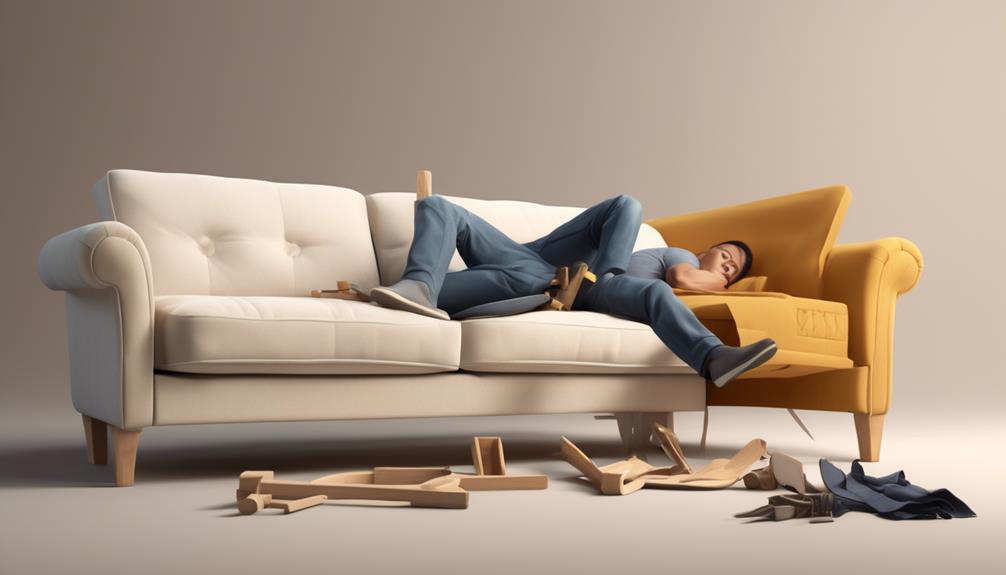
Now that we've successfully removed the feet and cushions, let's move on to the next step: disassembling the sofa.
Disassembling the sofa involves utilizing various techniques to break it down into smaller, more manageable pieces. We'll need a few essential tools, such as screwdrivers, pliers, and possibly a drill, to help us with the disassembly process.
However, we may encounter some challenges along the way, such as stubborn screws or tight-fitting components, but fret not, as we'll discuss potential solutions to tackle these obstacles effectively.
Sofa Disassembly Techniques
Using disassembly techniques, it's possible to break down and dismantle a sofa for easier transportation or fitting through a narrow doorway. Here are some practical tips on how to disassemble your sofa:
- Measure the sofa: Before beginning the disassembly process, measure the dimensions of your sofa to ensure it will fit through the desired space. Measure the height, width, and depth of the sofa, as well as any bulky components like armrests or recliners.
- Remove detachable parts: Start by removing any detachable parts such as cushions, legs, or armrests. This will make the sofa lighter and easier to maneuver.
- Follow the reassembly process: While disassembling, it's crucial to keep track of all the pieces and their respective locations. Take photos or label the parts to ensure a smooth reassembly process later on.
Tools Needed for Disassembly
To disassemble a sofa, you'll need a few essential tools to make the process easier and more efficient. These tools will help you overcome any obstacles that may arise during the disassembling techniques.
Firstly, you'll need a set of screwdrivers, including both Phillips and flathead, to remove any screws holding the sofa together.
Additionally, an Allen wrench set is crucial for loosening and tightening bolts.
A pair of pliers will come in handy for gripping and twisting stubborn fasteners.
To protect the sofa's upholstery, it's essential to have a pair of gloves and a drop cloth.
Lastly, a tape measure will help you ensure that all the pieces will fit through your door.
With these tools at your disposal, you'll be able to tackle any disassembly challenges that come your way.
Potential Challenges and Solutions
One potential challenge when disassembling a sofa is dealing with tight spaces and narrow doorways. This can make it difficult to maneuver the sofa through the doorway, especially if it's a tight fit. However, there are several solutions to overcome this challenge:
- Measure the doorway: Before attempting to disassemble the sofa, measure the width, height, and depth of the doorway. This will help you determine if the sofa can fit through or if it needs to be disassembled further.
- Disassembly techniques: If the doorway measurement indicates that the sofa won't fit, consider disassembling it further. Remove the legs, backrest, and any other detachable parts. This will make the sofa more compact and easier to navigate through narrow spaces.
- Seek professional help: If you're unsure about the disassembly process or if the sofa is too complicated to take apart, it's best to seek professional help. Furniture movers or technicians with experience in disassembling sofas can ensure a smooth and hassle-free process.
Hiring Professional Movers
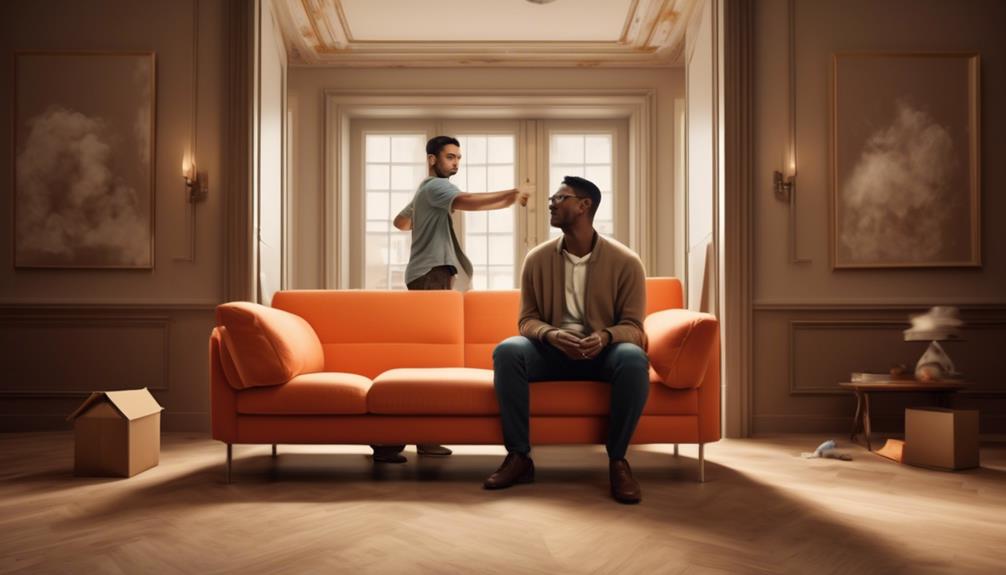
Hiring professional movers can greatly simplify the process of transporting your sofa through a narrow doorway. These experts have the experience and knowledge to handle even the most challenging situations, ensuring that your sofa arrives safely and intact in your desired location. In addition to their expertise, professional movers often have specialized tools and equipment that can make the task easier and more efficient.
To give you an idea of the benefits of hiring professional movers, let's take a look at a comparison table:
| Factors | DIY Approach | Professional Movers |
|---|---|---|
| Expertise | Limited knowledge of sofa disassembly techniques | Extensive experience and expertise in handling furniture |
| Tools and Equipment | Basic tools may not be sufficient | Specialized equipment for disassembling and moving sofas |
| Time and Effort | Requires time and effort to research, plan, and execute the move | Saves you time and effort by handling the entire process |
| Safety | Possibility of damaging the sofa or property | Ensures safety of your sofa and property through proper handling and packing |
As you can see, hiring professional movers can provide numerous advantages, ensuring a smooth and stress-free sofa transport. Their expertise, specialized equipment, and commitment to safety make them the ideal choice for navigating narrow doorways and other potential obstacles. So, when it comes to moving your sofa, it's worth considering the convenience and peace of mind that professional movers can offer.
Tips for Maneuvering in Tight Spaces

When maneuvering through tight spaces, it's essential to utilize techniques that maximize efficiency and minimize the risk of damage to your furniture and surroundings. Moving furniture can be a challenging task, but with the right measuring techniques and furniture moving hacks, you can make the process smoother and more manageable.
Here are some tips to help you navigate tight spaces with ease:
- Measure Twice: Before attempting to move any furniture, measure both the furniture and the available space. This will ensure a proper fit and prevent any unnecessary damage or frustration.
- Disassemble if Possible: If your furniture can be easily disassembled, such as removing legs or cushions, do so before attempting to move it. This will make it easier to navigate through narrow doorways or tight corners.
- Protect Your Furniture: To avoid scratches or dents, use furniture pads or blankets to wrap your pieces. This will provide a protective layer and make it easier to slide the furniture through tight spaces.
- Use Sliders: Furniture sliders are a game-changer when it comes to maneuvering in tight spaces. Place them under the legs or corners of your furniture to reduce friction and make it easier to slide the pieces across the floor.
- Take Your Time: Rushing through the process can lead to accidents or damage. Take your time, plan your moves carefully, and ask for help if needed. Patience and a strategic approach will go a long way in successfully maneuvering through tight spaces.
Using a Furniture Dolly
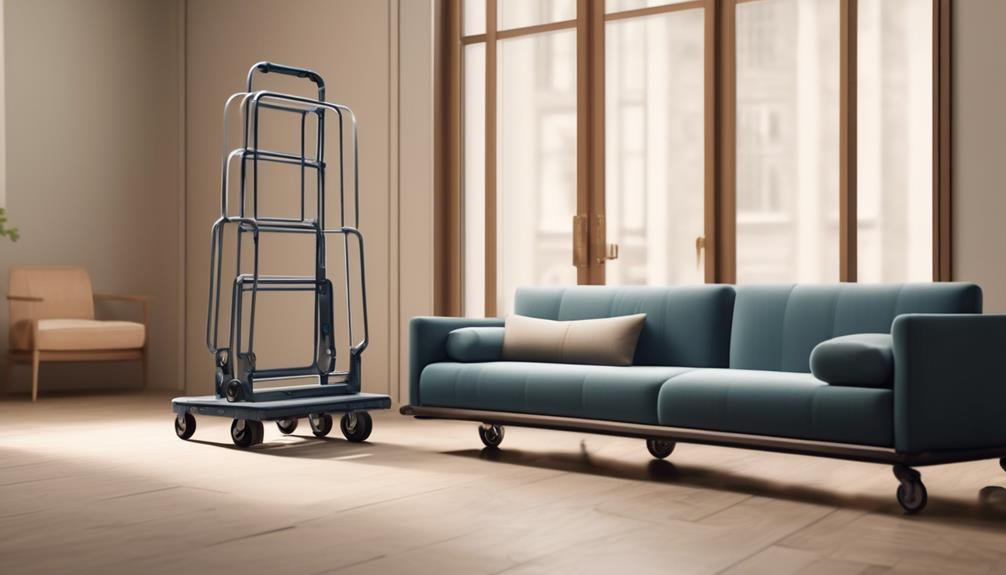
When it comes to moving heavy furniture like a sofa, using a furniture dolly can make the task much easier.
The key to successful maneuvering is to use proper techniques and measurements.
Proper Maneuvering Techniques
To properly maneuver a sofa through a door using a furniture dolly, we recommend employing effective techniques that maximize efficiency and minimize the risk of damage. Here are some practical tips to help you overcome maneuvering challenges and master furniture lifting techniques:
- Secure the sofa: Use straps or ropes to secure the sofa onto the dolly, ensuring it doesn't shift during the maneuver.
- Position the dolly: Place the dolly at an angle, allowing you to slide the sofa smoothly through the doorway.
- Coordinate your movements: Work as a team, with one person guiding the dolly and another person supporting the sofa from the other end.
- Communicate effectively: Use clear, concise instructions to ensure coordination and avoid accidents.
Measuring Door and Sofa
Using a furniture dolly, we can accurately measure the dimensions of both the door and the sofa to ensure a proper fit during the maneuver.
To start, measure the width of the sofa by placing the dolly next to it and extending the tape measure from one side to the other. This will give you an accurate measurement of the sofa's width.
Next, measure the door frame clearance by placing the dolly at the entrance of the door and measuring the distance between the door frame and any obstacles such as handles or trim. This measurement will determine if the sofa can be maneuvered through the door without any obstructions.
Utilizing Blankets and Sliders
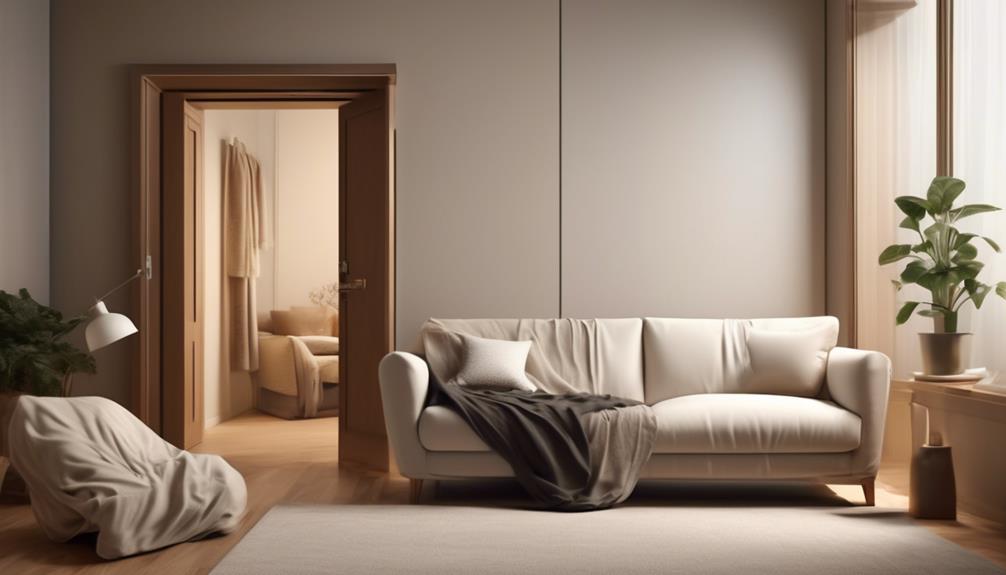
We can effectively maneuver a sofa through a door by strategically utilizing blankets and sliders.
When it comes to blankets, proper folding is crucial. Start by folding the blanket in half lengthwise, then fold it in half again. This will create a thick cushioning layer that can protect both the sofa and the door frame from any potential scratches or damage during the moving process.
In terms of sliders, there are various types available that can make the task easier. Here are three popular options:
- Furniture sliders: These small discs or pads are designed to be placed under the legs or corners of the sofa, allowing it to slide smoothly across the floor. They come in different materials such as plastic or felt, depending on the type of flooring in your home.
- Carpet sliders: If you have carpeted floors, carpet sliders are a great option. These sliders have a smooth surface on the bottom and a gripper top that securely holds onto the carpet, minimizing any resistance while moving the sofa.
- Airbags: Airbags are inflatable cushions that can be placed under the sofa to lift it slightly off the ground, reducing friction and making it easier to move. They're particularly useful when dealing with heavy sofas or tight spaces.
Alternative Entrance Options
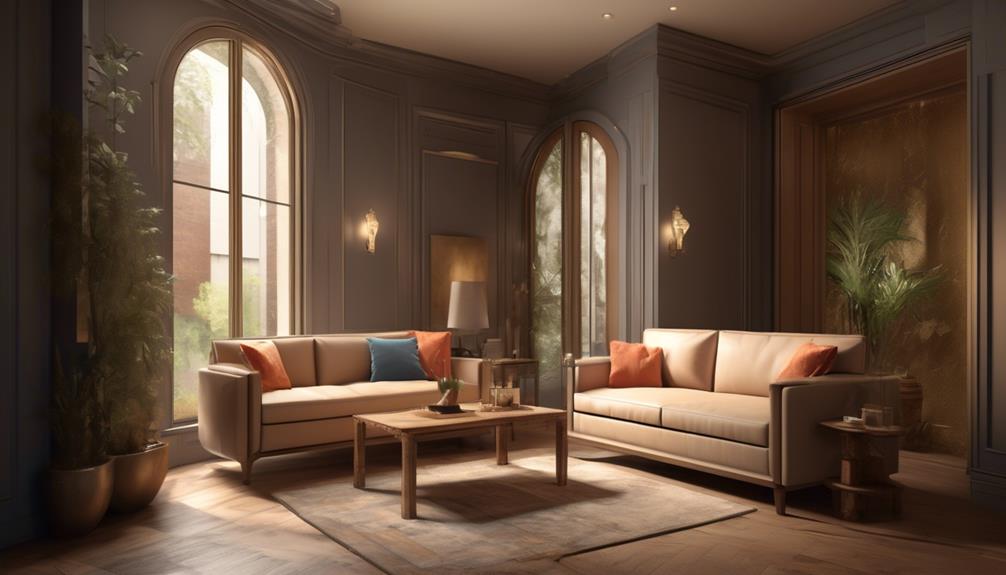
After successfully utilizing blankets and sliders to protect the sofa and maneuver it through the door, it's important to consider alternative entrance options for situations where the door is too narrow or the sofa is too large to fit through. When faced with such challenges, there are several practical solutions you can explore to ensure your sofa finds its rightful place in your home.
One option is to remove the door from its hinges. This provides a wider opening and allows for easier maneuvering of the sofa. However, it's essential to exercise caution and seek assistance to prevent any damage to the door or surrounding walls.
Another alternative is to disassemble the sofa, if possible. Check if the legs can be unscrewed or if any modular sections can be detached. This can significantly reduce the size of the sofa and make it easier to navigate through narrow doorways or tight corners.
If neither of these options is feasible, you may need to explore alternative entrances. Consider using a balcony or patio door, if available, as they often have larger openings. Additionally, ground floor windows or sliding glass doors can be utilized as entry points, especially if they are closer to the desired location for the sofa.
Remember, when utilizing alternative entrance options, it is crucial to prioritize safety and seek assistance if needed. By thinking creatively and being resourceful, you can find a way to bring your beloved sofa into your home, no matter the challenges you face.
| Alternative Entrance Options | Pros |
|---|---|
| Remove door from hinges | – Provides wider opening<br>- Easier maneuvering |
| Disassemble the sofa | – Reduces size of the sofa<br>- Easier navigation through narrow spaces |
| Utilize balcony or patio door | – Larger openings |
| Use ground floor windows or sliding glass doors | – Closer to desired location<br>- Potential for larger openings |
When to Consider a Different Sofa
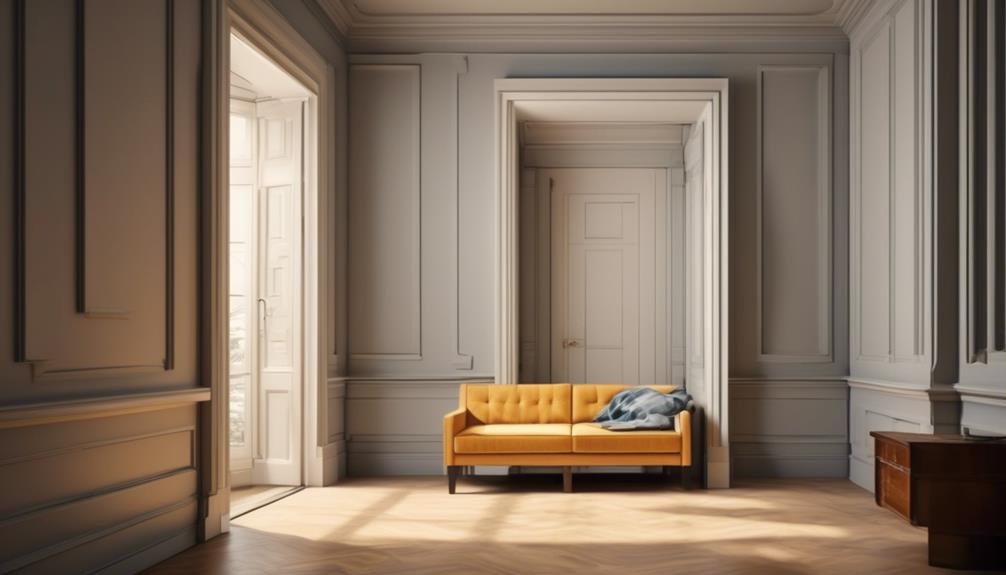
Considering a different sofa may be necessary if the current one can't be successfully maneuvered through the door or if it doesn't fit well in the desired location. It can be disheartening to realize that your dream sofa doesn't quite fit into your living space. However, there are alternative sofa options to consider and alternative furniture arrangements that can help you find the perfect fit.
Here are some factors to consider when deciding if a different sofa is the right choice for you:
- Size and dimensions: Measure your doorway and the space where you want to place the sofa. If the dimensions of your current sofa exceed these measurements, it may be time to explore other options.
- Style and design: If the current sofa doesn't match your aesthetic preferences or the overall theme of your space, it might be worth exploring different styles and designs that will better suit your taste.
- Comfort and functionality: If your current sofa doesn't provide the level of comfort or functionality you desire, it may be worth considering a different sofa that better meets your needs.
Common Mistakes to Avoid

One common mistake to avoid when choosing a sofa is failing to measure the door and entryway properly. It may seem like a simple task, but many people overlook this crucial step and end up with a sofa that won't fit through the door. To help you avoid this headache, we have compiled a list of common measuring mistakes and door frame preparation tips to ensure a smooth and successful sofa delivery.
| Measuring Mistakes | Door Frame Preparation |
|---|---|
| Not measuring the height, width, and depth of the sofa accurately | Removing doors or hinges if necessary |
| Forgetting to account for any obstacles or narrow passages along the way | Clearing the pathway of any obstacles or furniture |
| Neglecting to measure the height, width, and depth of the door and entryway | Checking the door frame for any loose screws or damaged parts |
| Failing to consider the angle at which the sofa needs to be maneuvered | Applying lubricant to squeaky hinges for smooth movement |
Ask for Manufacturer's Assistance
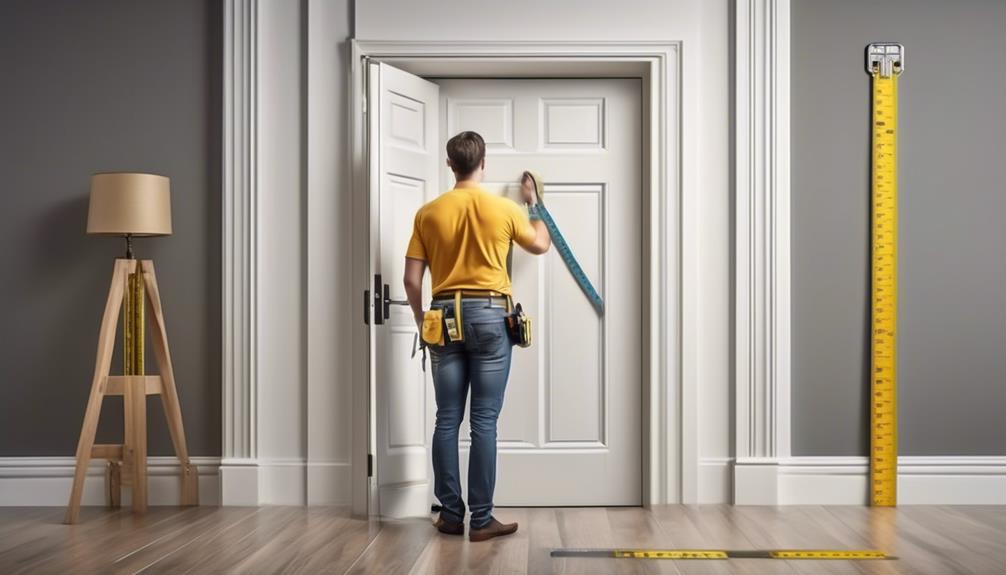
When it comes to fitting a sofa through a narrow door, asking for the manufacturer's assistance can be a game-changer.
The manufacturer's expert advice can provide valuable insights and specific instructions tailored to your sofa model. Additionally, they can guide you on accurate door measurements to ensure a proper fit or suggest disassembling options for easier transportation.
Seeking the manufacturer's assistance can save you time, effort, and potential damage to your sofa.
Manufacturer's Expert Advice
To ensure a successful fit of your sofa through your door, it's recommended to seek the expert advice and assistance from the manufacturer. The manufacturer is well-versed in the specific dimensions and design of their product, making them the best resource for guidance.
Here are some reasons why reaching out to the manufacturer is crucial:
- Measuring Techniques: Manufacturers can provide precise instructions on how to measure your door and the sofa accurately. They may even recommend specific tools or techniques to ensure the measurements are precise.
- Potential Obstacles: Manufacturers have extensive knowledge of potential obstacles that could hinder the sofa's entry into your home. They can advise you on any necessary disassembly, maneuvering techniques, or alternative solutions to overcome these obstacles.
- Custom Solutions: Manufacturers may offer customized options or modifications to the sofa to ensure it fits perfectly through your door. They can provide insights into any adjustments that can be made without compromising the sofa's integrity.
Door Measurement Accuracy
Seeking the manufacturer's assistance for door measurement accuracy is essential when ensuring a successful sofa fit through your door. When it comes to measuring tape accuracy, it's crucial to use a reliable and well-calibrated tool. A small error in measurement can lead to significant problems when trying to navigate a sofa through a narrow doorway.
To measure the door frame width accurately, start by removing any obstacles or decorations that may interfere with the measurement process. Place the measuring tape at the widest point of the door frame and record the measurement. Repeat the process at different heights to ensure consistency. Remember to measure from the inside edge of the frame.
Disassembling for Easy Transport
For easy transport, it's advisable to consider disassembling the sofa. Seeking assistance from the manufacturer can be incredibly helpful in this process.
Disassembling a sofa can help overcome size and maneuverability challenges, making it easier to fit through narrow doors and tight corners. Here are three ways the manufacturer can assist you in disassembling your sofa:
- Expert Guidance: The manufacturer can provide detailed instructions on how to disassemble your specific sofa model, ensuring a smooth and efficient process.
- Specialized Tools: They may also recommend or provide specialized tools designed specifically for disassembling their sofas, making the task easier and more efficient.
- Knowledge of Hidden Fasteners: Manufacturers are familiar with the hidden fasteners and mechanisms used in their sofas, which can be tricky to locate and disassemble. Their expertise can save you time and frustration.
Final Thoughts and Tips
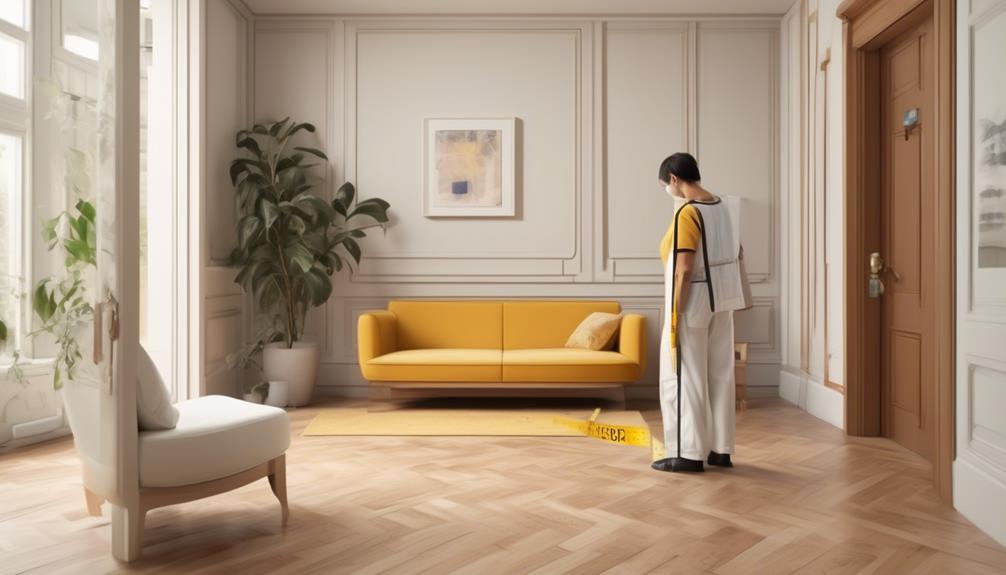
After carefully considering all the factors, we've compiled a list of practical tips and final thoughts to ensure a successful sofa fit through your door.
When it comes to hiring professional help, it can be a wise decision if you're unsure of your own abilities or if you have a particularly challenging doorway or staircase to navigate. Professionals have the expertise and experience to handle tricky situations and can save you time and stress.
However, if you prefer to tackle the task yourself, there are alternative furniture options to consider. Sofas with removable arms or modular designs can make transportation easier as they can be taken apart and reassembled. Additionally, collapsible or inflatable furniture can be a practical choice, especially for those living in small spaces or frequently moving.
Before making a decision, carefully measure your doorways and passages, and consider the dimensions of the sofa you wish to bring in. By being well-prepared and considering all available options, you can ensure a successful and stress-free sofa fit through your door.
Frequently Asked Questions
Can I Remove the Door to Make It Easier to Fit the Sofa Through?
Removing the door can be a practical solution when trying to fit a sofa through a narrow doorway. It provides extra space and flexibility during the process.
However, before taking this step, it's important to consider alternative solutions. For instance, measuring the sofa and the doorway to assess if it can fit diagonally or by removing the legs.
Additionally, seeking professional help or consulting with a furniture expert can offer valuable insights and ensure a smoother transition.
Are There Any Weight Restrictions When Disassembling a Sofa?
Weight restrictions are an important consideration when disassembling a sofa. It's like juggling delicate china plates; you don't want to drop any and risk damage.
Make sure to consult the manufacturer's guidelines or speak to a professional to ensure you stay within the recommended weight limits. By doing so, you'll ensure a smooth and successful disassembling process without any unexpected surprises.
Safety first, after all, for both you and your sofa!
How Do I Protect My Walls and Floors When Moving a Sofa?
When moving a sofa, it's important to protect our walls and floors. To safeguard the walls, we can use furniture sliders or blankets to create a barrier between the sofa and the wall. Additionally, we can apply painter's tape to the corners and edges to prevent any accidental bumps or scratches.
To protect our floors, placing a durable plastic sheet or cardboard underneath the sofa can prevent any damage or scuff marks.
These simple steps ensure a smooth and worry-free sofa-moving experience.
Is It Possible to Hire a Professional to Assemble the Sofa After It's Been Moved?
Is it possible to hire a professional to assemble the sofa after it's been moved? Absolutely! Professional assembly services are a convenient option for those who prefer expert assistance. They can save you time and ensure that your sofa is put together correctly.
It's like having a skilled chef prepare a gourmet meal for you, leaving you with a perfectly assembled sofa to enjoy.
However, if professional assembly isn't feasible, consider alternative furniture options that are easier to move and assemble on your own.
Are There Any Specific Tools I Need to Disassemble a Sofa?
When it comes to disassembling a sofa, there are a few tools that you may need. A screwdriver, preferably with different-sized bits, will come in handy for removing screws and fasteners. An Allen wrench might also be necessary for certain sofa models. Additionally, having pliers can help with any stubborn hardware.
As for the disassembly process, it's important to follow the manufacturer's instructions, as each sofa may have different mechanisms. Taking your time and being gentle will ensure a smooth disassembly process.
What Is the Secret to Fitting a Sofa Through Any Doorway?
When facing the dilemma of solving sofa door dilemma, consider removing the sofa legs or taking apart any modular sections. Measuring the doorway and sofa dimensions beforehand can also ensure a smoother fitting process. Additionally, using a professional moving company that specializes in tricky furniture maneuvers can provide a solution.
Conclusion
In conclusion, measuring your doorway and considering the dimensions of your sofa are crucial steps to determine if it will fit through your door.
However, if you find that your sofa won't fit no matter what you try, you're not alone. According to a recent survey, 15% of people have had to return or exchange furniture because it didn't fit through their door.
Remember to always consult with the manufacturer for assistance and explore alternative sofa options if needed.
- About the Author
- Latest Posts
Introducing Ron, the home decor aficionado at ByRetreat, whose passion for creating beautiful and inviting spaces is at the heart of his work. With his deep knowledge of home decor and his innate sense of style, Ron brings a wealth of expertise and a keen eye for detail to the ByRetreat team.
Ron’s love for home decor goes beyond aesthetics; he understands that our surroundings play a significant role in our overall well-being and productivity. With this in mind, Ron is dedicated to transforming remote workspaces into havens of comfort, functionality, and beauty.

Purchasing a leather couch is a significant investment. Leather sofas not only come with a higher price tag compared to fabric ones but also demand more maintenance. This blog post aims to provide you with a quick overview of leather sofas.
We’ll cover everything from leather sofa shopping tips to how to care for your leather sofa. We’ll even touch on the different types of leather sofas and some of the best leather sofa brands. By the end of this post, you should have a good understanding of leather sofas and how to buy one that will last.

Leather Sofa Shopping Tips
When shopping for a leather sofa, it is important to be aware of the different types of leather and what to look for. For example, some sofas are made with cowhide leather, considered a higher quality leather than other types. Additionally, it is important to consider the warranty that comes with the purchase of the sofa. A good warranty will cover any defects in the material or workmanship for a set period. Lastly, regular care should be taken when sitting on or reclining on a leather sofa. To avoid damage, avoid using heavy items on the surface, refrain from cleaning with harsh chemicals, and protect the couch with an appropriate cloth protector when not in use.
Leather is a very delicate material and should be treated with care. Regular cleaning with a mild soap and water will help keep the sofa looking new. To avoid damage, do not use harsh chemicals or cleaners on the surface of the leather. When not in use, protect the couch with an appropriate cloth protector.
How To Shop For A Leather Sofa
If you’re considering purchasing a leather sofa, there are a few things to remember. First of all, make sure that the couch is the right size for your home. You don’t want it to be too small or too large – you’ll only end up unhappy with it. Secondly, inspect the seams and edges of the couch for any irregularities or damage. This will help ensure that your investment is worth it in the long run.
The next thing to consider is what type of leather you want. There are several different types available, each with its own set of benefits and drawbacks. Ultimately, you’ll have to decide which one suits your needs best. Some people prefer softer leathers while others prefer harder ones – it’s all about finding what works best for you.
Finally, consider how often you plan on using your couch and whether or not repairs or replacements are necessary over time. If you tend to abuse your furniture, then repairs may become necessary more frequently than if you take care of it properly. However, if you keep your furniture well-maintained by regularly cleaning and conditioning it, then repairs may barely ever occur at all!
Leather Sofa Buying Guide
Leather sofas are a popular choice for many people, and there are a variety of different types of leather available. This guide will help you to understand the different types of leather and what to look for when buying a sofa. It will also provide tips on how to care for your new leather sofa, so that it can last long term.
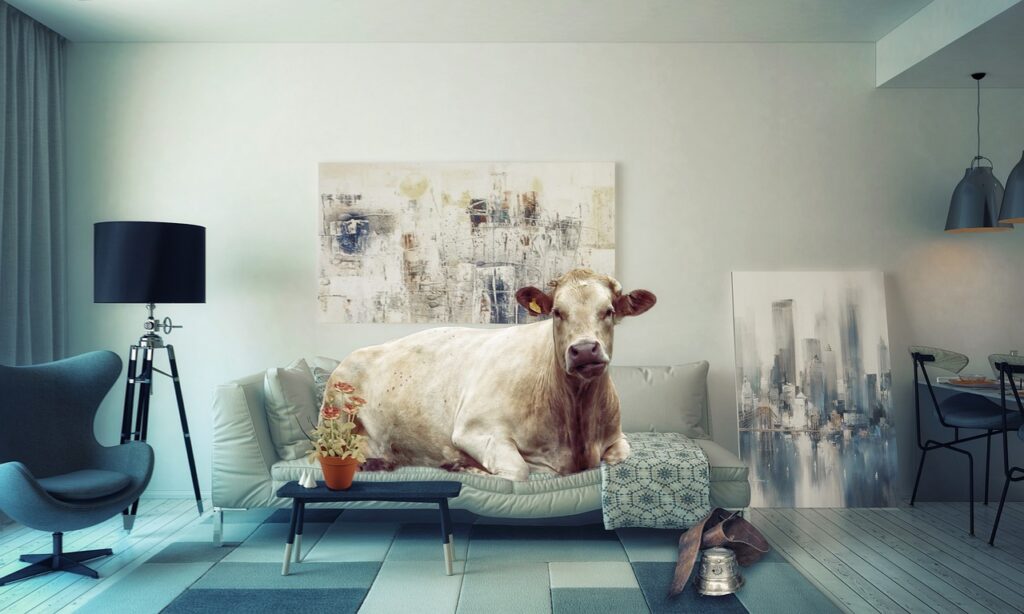
There are several different types of leather, each with its unique features and benefits. Here is a summary of the most common types of leather used for sofas:
Cowhide: This type of leather is the most popular because it’s durable, comfortable, and easy to clean. It has a matte finish, which makes it look rustic and natural. Cowhide is also available in different colors, such as black, brown, beige, or tan.
Anchor Leather: Anchor leather is made from the skin around an animal’s anchor limb (a leg that extends out from the body). This type of leather has a high quality reputation because it’s resistant to water damage and fading. It has a grainy texture that gives it a textured look. Anchor Leather can be found in shades such as light grey or blue grey.
Biker Leather: Biker leather is made from the skin on the front side of cowhides lying flat on their backs. The hide must be at least two inches thick before being processed into motorcycle saddle material. Because biker leather contains more layers than other types of cowhide, it usually costs more than other types of leather furniture. Biker Leather can be found in darker colors such as black or brown.
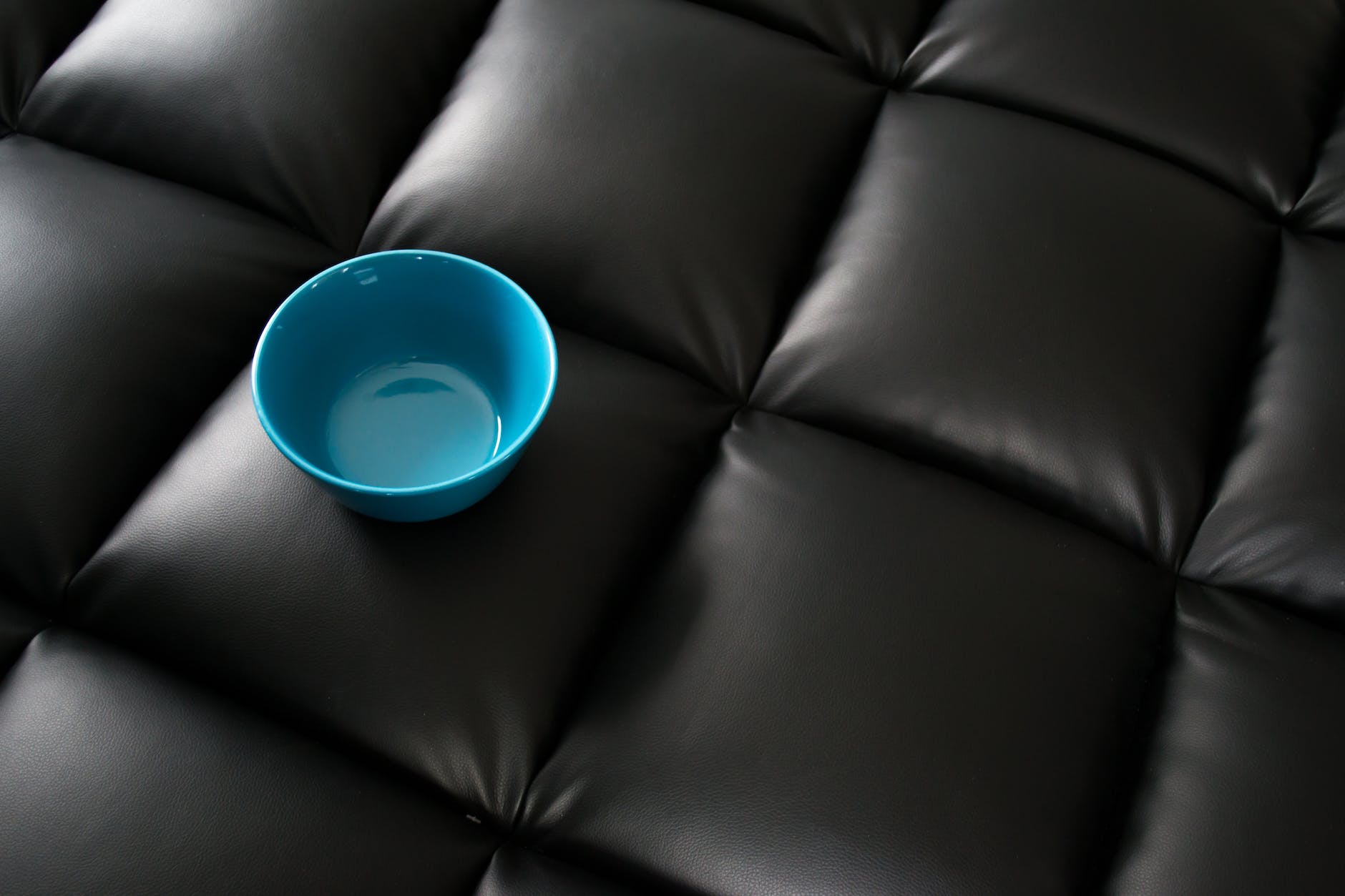
What To Avoid When Buying A Leather Sofa
When it comes to buying a leather sofa, there are a few things that you should keep in mind. First and foremost, don’t overspend. A good rule of thumb is spending no more than 30% of your budget on a leather sofa. This way, you’ll be able to get a high-quality couch without breaking the bank.
Another important thing to keep in mind is warranties. Most companies offer at least a one-year warranty on their leather sofas. If something does go wrong during that time period, don’t hesitate to take advantage of the warranty.
Do your research before buying a leather sofa. Not all sofas are created equal. Make sure that you’re looking for an actual leather sofa, rather than a cheap knock-off version. Additionally, be sure to read reviews and compare prices before making your purchase.
How To Care For Your Leather Sofa
If you’re considering purchasing a leather sofa, it’s essential to consider the leather’s quality. There are a few things that you can look for when shopping for a leather sofa:
- The hair on the hide should be uniform and free from blemishes.
- The color of the hide should be even and consistent throughout.
- The grain should run straight, without any bumps or inconsistencies.
- The hide should feel soft to the touch and have no rough patches.
If you’re unsure whether your chosen leather couch is of high quality, consider consulting with a professional before making your purchase. Quality leather sofas can last many years, and may be worth the investment if you’re looking for an aesthetically pleasing piece of furniture that will also function well. Here are some tips on how to care for your new leather sofa:
Regularly vacuum the cushions and upholstery using a soft brush attachment on your vacuum cleaner. Avoid harsh chemicals or abrasives as this could damage the surface fabric over time.
Protect your couch from spills by placing an absorbent material underneath when hosting large gatherings or dinner parties – this will help to soak up any liquid that might escape onto the sofa surface. If there is still spillage afterwards, blot it dry with a cloth instead of rubbing it in!
The Different Types Of Leather Sofas
Leather sofas are a popular choice for many people, and there are a variety of different types to choose from. This article will discuss the different types of leather sofas and help you identify the right one. Additionally, each style will have its own set of benefits. So don’t wait any longer – learn about all the different kinds of leather sofas here!
There are three main types of leather sofas: traditional, contemporary, and transitional. Traditional leather sofas are the most popular option and come in various shapes and sizes. They are often very comfortable and can last for many years, but they may not be as stylish as other options.
Contemporary leather sofas are similar to traditional ones but have a more modern look. They tend to be more lightweight and less bulky, making it easier to move around. Transitional leather sofas are a mix of both traditional and contemporary styles. They typically have features from both types of sofas, which makes them very versatile – you can find one that suits your needs perfectly!
Type of leather for a sofa
Leather is a popular choice for furniture, and it’s not hard to see why. It looks great and can last forever if taken care of properly. However, there are many different types of leather out there. If you’re buying a new sofa or any other piece of furniture in which you want the leather to be the primary material, then it’s important to know what kind of leather your item is made from before purchasing it.
There are several things about the type of leather that will determine how well it holds up over time: whether it’s full-grain or top-grain, what kind of animal skin was used (cows vs goats vs sheep), etc… In this article we’ll go over all these factors so that when you’re ready to buy a new sofa (or whatever else) made with leather—whether it’s my own personalized design or something else—you’ll be able to get exactly what you want based on your budget and needs!
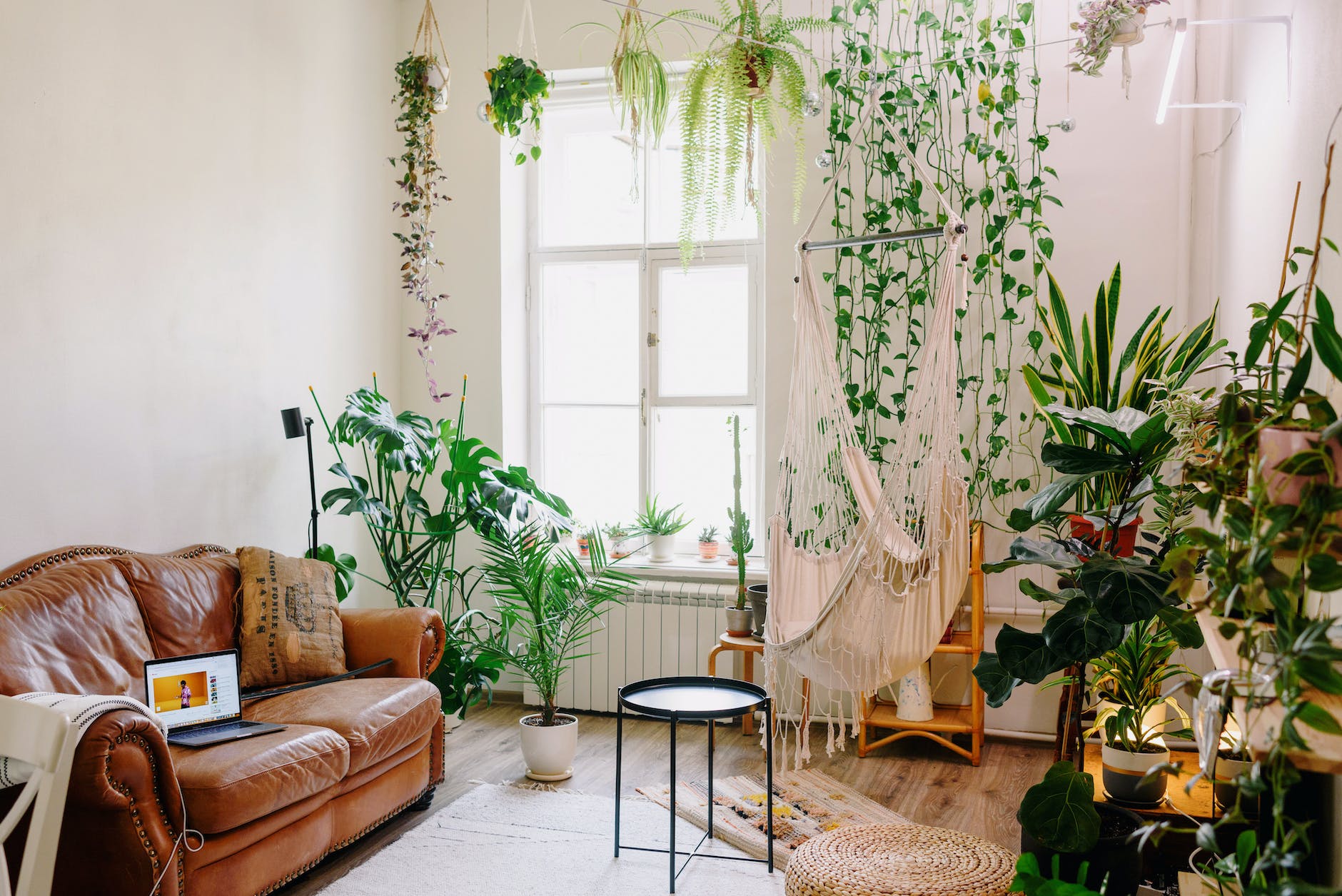
Split Leather
Split leather is the leftovers from top-grain leather. It’s significantly cheaper than top-grain, but it’s also less durable, so you’ll likely want to consider this material if you’re concerned about the long-term resilience of your sofa. Top and bottom split leathers are also available, which are even cheaper than regular split leathers and, therefore better suited for heavy-use areas such as family rooms or dens.
Top-Grain Leather
Top-grain leather is the highest quality leather available. This type of leather is so durable that it can be used for heavy-duty items such as footwear, handbags and furniture upholstery. Top-grain leather is made from the hide’s top layer, making it incredibly strong and easy to clean. Top-grain leather can also be embossed and pigmented to create various looks (such as suede or nubuck). It’s easy to work with because it’s soft yet thick enough to hold its shape during cutting and sewing processes; this makes it ideal for applications where durability matters most like upholstery or automotive interiors.
Top grain has a more pronounced grain than genuine leather which makes it easier to dye because there are fewer imperfections in the surface which could interfere with dye penetration when dying top grain cowhides into hides (which would happen if they were left natural).
Full-Grain Leather
Full-grain leather is the highest quality and most durable type of leather available. It refers to the outermost layer of the hide, which contains all of the natural grain. This means that when you look at full-grain leather, you see all of its natural imperfections and its authenticity and durability. Because it’s a natural product, full-grain leather can have minor blemishes or variations in color (including white lines known as “cracks”).
Full-grain leather is ideal for furniture because it will stand up well to wear over time: no synthetic fabrics or paints cover up weak spots in lower grades of leather. As long as you keep your sofa clean with regular vacuuming or spot cleaning, it can last for decades with proper care!
Bonded Leather
Bonded leather is a cheap option that’s made from a mix of leather scraps and synthetic materials. While it’s popular for its affordability, bonded leather isn’t as durable or comfortable to sit on. If you’re looking for something that will last a long time but you don’t have the money for real leather, then this may be the best option for you—but if not, other types of faux-leather furniture may suit you better.
The Types of Leather so You Can Know What to Look For
The type of leather you choose will determine the quality and durability of your sofa, so it’s important to know what each type is.
The most common type of leather used in sofas is split leather, made from the leftovers after the top-grain has been removed from a hide. It’s then pressed together and glued to create a faux grain. It’s cheaper than top-grain but still feels soft and looks good for years with proper care.
Top grain leather is slightly higher quality than split grain because it comes from hides that are sanded down and not processed enough to be considered full grain (see below). Top grain has a smooth surface and can be found on some low-end couches as well as high end ones—but don’t let this fool you into thinking that all top grains are created equally!
Full grain leather comes from the highest quality hides available, meaning they have not been sanded down at all or buffed out in any way like other types of leather do; instead they still have their natural appearance intact which means there’s no need for gluing or dying during manufacturing process either!
Customizing Your Leather Sofa
When shopping for a leather sofa, it’s essential to consider the different types of leather and what to look for in a quality piece. There are many factors to consider when purchasing a leather sofa, including color, texture, and grain.
There are also many benefits to customization. For example, you can choose the size and shape of your sofa and the color and fabric. Additionally, customizing your couch can add character and personality to your home.
There are a number of ways to customize your leather sofa. You can choose the size, shape, color, and fabric. Additionally, you can add personalization such as initials or a favorite quote.
Adding personalization is an easy way to give your couch a unique look that will match your personality. Plus, it’s a great way to commemorate special moments in your life. Whether you’re looking for something simple or want to go all out, there’s sure to be a personalized leather sofa option that suits your needs.
Leather Sofa Brands
When it comes to buying a leather sofa, there are many things that you should consider. The quality of the leather is one of the most important factors. You want high-quality leather that will last for many years. Another important factor to consider is the type of construction. Make sure that the sofa is built with strong materials to withstand heavy use. Finally, consider how comfortable the sofa is. Some sofas are stiff and uncomfortable, while others are soft and plush. Lastly, be sure to evaluate the style of the sofa and whether or not it matches your home décor. Many reputable leather sofa brands are available on today’s market, all at different prices. It’s up to you to decide which one is right for you!
How To Choose The Perfect Cushion Fill For Your Leather Sofa
When choosing the perfect cushion fill for your leather sofa, it is important to identify quality leather. There are many different types of leather, each with its own benefits and drawbacks. It is important to choose the right type of leather for your sofa, as this will determine how well it will hold up over time.
Top-grain and full-grain leather is also important to consider when buying a leather sofa. Top grain refers to the skin’s surface, while full-grain refers to the center of the skin where the fibers are closest together. Full-grain leather is typically more expensive than top-grain leather, but it offers greater durability and better protection from wear and tear.
One of the most important factors to consider when purchasing a new leather sofa is comfort. You must find a couch that fits your lifestyle and preferences. While there are many different types of sofas on the market, finding one that truly suits your needs can be difficult. To get started on finding the perfect couch for you, consult with an experienced furniture retailer or online resource like Sofa Finder.com.
The Benefits Of Different Cushion Fills For Leather Sofas
Leather sofas are a popular choice for many people, and many different types of cushion fills are available. This article explores the benefits of each type of cushion fill and how they can benefit your sofa.
A foam cushion fill is the cheapest and most common type of cushion fill. It is soft, comfortable, and provides good support. However, foam cushions do not last long and can become worn out after a few years. Foam cushions are also not very durable, so they may not be suitable for use on furniture that will be regularly moved or handled.
A feather-filled cushion is similar to a foam cushion in terms of comfort and support. However, feathers are much more durable than foam; this makes them better suited for use on furniture that will be regularly moved or handled. Feathers also provide more warmth than foam; this can be useful in cold climates or during winter when heating bills are high. Finally, some people have allergies to feathers, meaning feather-filled cushions may be preferable for them over other types of cushions.
The Proper Cushion Fill For Your Leather Sofa
There are a few different types of cushion fill that can be used for leather sofas. They are fiber, foam, and polyurethane. Each has its own unique set of benefits and drawbacks. We will discuss each type in detail below.
Fiber is the most traditional type of cushion fill. It is made up of small pieces of fiber that are bonded together with heat and pressure. This makes it very durable and resistant to spills and stains. However, fiber is not as soft or comfortable as cushion fill. Additionally, it can take a while to recover from a Fiber sofa fill damage.
Foam is a popular type of cushion fill because it is both soft and comfortable. It is made up of small bubbles that expand when heated. This makes it very elastic, which makes it great for contouring to your body shape. However, foam tends to lose its shape over time.
Polyurethane is a hybrid between foam and fiberfill. It has some properties of both foam and fiberfill but also has the durability of polyester. This makes it a good choice if you want the comfort benefits of foam but don’t want the stiff feel common with fiberfill cushions.
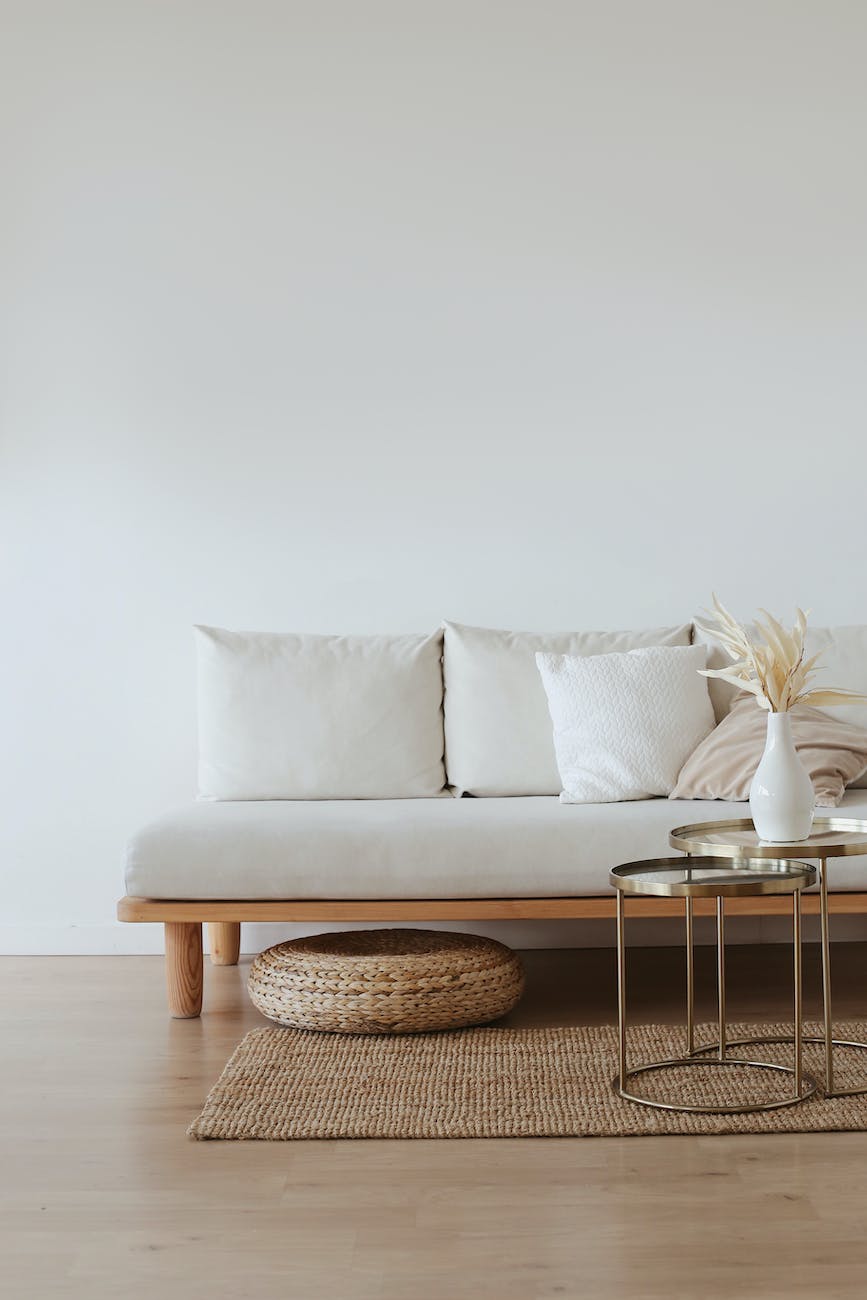
Selecting The Right Cushion Fill For Your Leather Sofa
There are many different types of cushion fill available on the market, and it can be difficult to decide which one is best for your leather sofa. This article will outline some of the main factors to consider when selecting a cushion fill for your sofa, as well as provide an overview of some of the most common types of cushion fills.
When selecting a cushion fill, it is important to consider both the type of sofa you have, as well as your personal preferences. For example, if you prefer a firmer seating experience, you might prefer a foam or rubberized cushion fill. On the other hand, if you are more comfortable with a softer seat, you might choose something like down or feather mattress filling.
It is also important to consider how much padding your sofa needs. Most sofas come with either standard or extra-thick cushions, and each has its own pros and cons. For example, extra-thick cushions are more durable and resistant to wear and tear, but they can also be less comfortable than standard cushions. Conversely, standard cushions tend to be more affordable but may not provide enough support in hard seats.
Finally, it is worth noting that not all types of cushion fills are available in every size or shape. So, if you want to add customizability and flexibility into your purchasing decision, it is important to research different types of cushion fills before making a purchase.
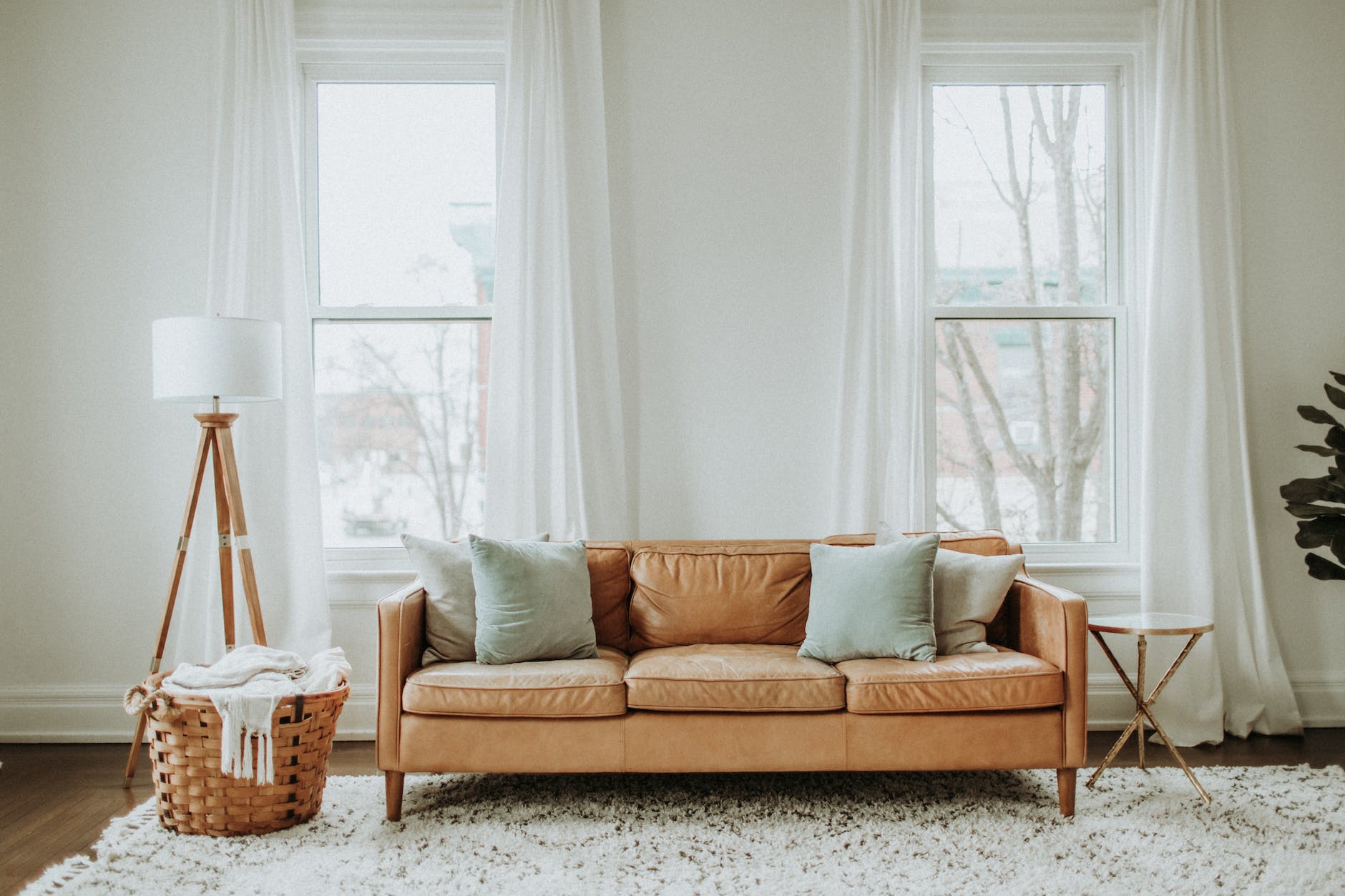
Why You Should Choose The Right Cushion Fill For Your Leather Sofa
If you’re thinking of buying a new leather sofa, one of the first things you’ll need to do is decide on the cushion fill. Choosing the wrong type of cushion fill can ruin your new sofa in just a few months. Not only will this cause discomfort, but it can also lead to wear and tear on the fabric.
There are many types of cushion fills to choose from, so it’s important to do some research before making a purchase. Once you have decided on the filling that best suits your needs, be sure to buy it from a reputable source. This way, you’ll be able to ensure that you’re getting the best quality product for your money.
There are a few things to consider when selecting a cushion fill. First, you’ll want to decide on the type of foam you want to use. There are several different types of foam, each with its own benefits and drawbacks. Some foams are more durable than others, so it’s important to choose one that will stand up to regular use.
Another factor to consider is the level of comfort you’re looking for. Some cushion fills are designed specifically for leather sofas, while others work well in any type of seating. Once you have decided on the type of foam and the level of comfort you need, be sure to test out the filling before making your purchase. This way, you can be sure that you’re getting the best possible product for your money.
How To Get The Most Out Of Your Leather Sofa By Choosing The Right Cushion Fill
If you’re in the market for a new leather sofa, be sure to consider the type of cushion fill that is available. Down, polyester, or foam cushions each have their own benefits and drawbacks. Down is the most natural and comfortable option, but it can be heavy and expensive. Polyester is a good middle ground because it’s not as durable as down but it’s more affordable. Foam cushions are the most popular option today, because they are both comfortable and stylish. However, they may not last as long as other types of cushion fills. Be sure to test out your chosen sofa before you buy it to make sure that it’s going to be a good fit for you.
Down is a great option for people looking for the most natural and comfortable cushion. Down is made from goose feathers that have been shredded and then filled with a material like foam or air. This makes it very soft, but it can also be heavy and expensive. If you’re concerned about price, down alternative options are available, such as polyester or foam cushions.
Polyester is a good middle ground because it’s not as durable as down but it’s more affordable. Foam cushions are the most popular option today, because they are both comfortable and stylish. However, they may not last as long as other types of cushion fills. Be sure to test out your chosen sofa before you buy it to make sure that it’s going to be a good fit for you.
If you’re on a budget, consider opting for a foam cushion instead of an all-down option. Foam cushions are generally cheaper than down alternatives and they tend to hold their shape longer too, which means that they will provide more comfort over time than an all-down sofa would.
They do come with some downsides though; foam cushions aren’t particularly durable so they may not last as long as more expensive options might, and they can look less formal than all-down sofas if you’re looking for something flashy in your living room.
Different Types Of Cushion Fills For Different Types Of Leather Sofas
There are different types of cushion fills that can be used for different types of leather sofas. Feather is the most popular type of cushion fill, followed by foam and down. Here are some more details about each type:
Feather: Feather is a soft feather-like material that is often used as a filler in sofas because it is comfortable and provides good support. It is also environmentally friendly, as it does not produce any waste when it is used.
Foam: Foam is a common type of cushion fill because it is durable and provides good support. It can also be compressed very tightly, which makes it ideal for use in sofas that need to be compactly stored or transported.
Polyester fiber: Polyester fiber is a strong synthetic fiber that has been used as a filler in sofas for many years. It offers good durability and support, as well as being lightweight and easy to compress.
Down: Down is a soft and fluffy type of feathers that is often used as a filler in sofas because it is comfortable and provides good support. It is also environmentally friendly, as it does not produce any waste when it is used. Down is usually the most expensive type of cushion fill to purchase, but it offers the best value for money because it lasts longer than other types of cushion fills.
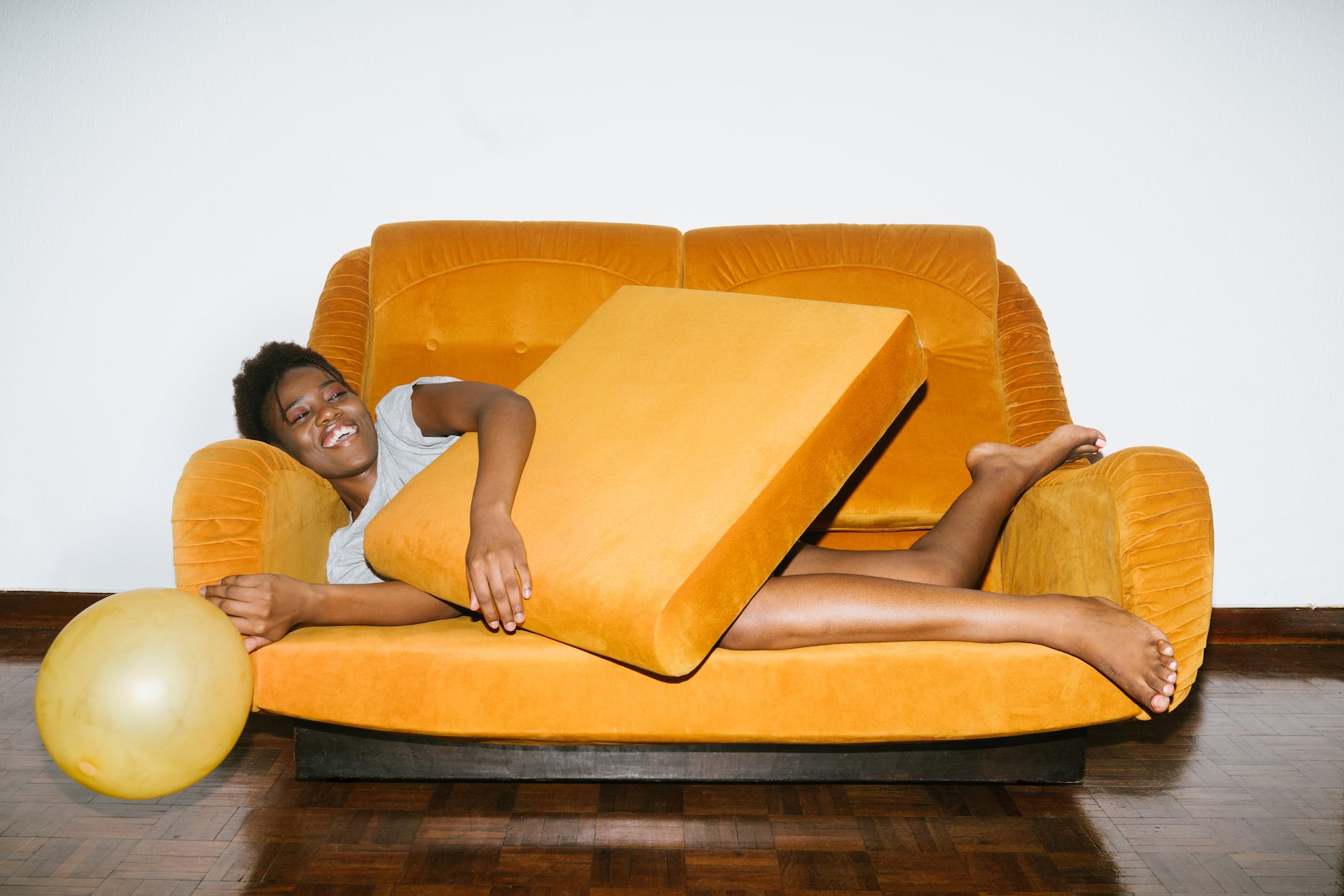
Making Sure Your Leather Sofa Lasts With The Proper Cushion Fill
Leather sofas are often a popular choice for people who want a high-end look and feel. However, leather sofas can be expensive to maintain, and they can suffer from various problems if the cushion fill is not used properly. In this section, we will discuss what type of cushion fill to use for a leather sofa, how often to replace it, and how to clean it.
When purchasing a leather sofa, it is important to choose the right type of cushion fill. This will depend on the condition of the sofa and your specific needs. For example, if you frequently sit in one position or move around rarely, a memory foam cushion would be a better option than an air conditioning gel cushion. On the other hand, if you spend most of your time sitting still in one spot or moving very little, an air conditioning gel cushion may be more appropriate.
It is recommended that you replace the cushions every 6-12 months depending on your lifestyle and activity level. It is also essential to keep the cushions clean by using a good cleaner whenever necessary.
To Wrap Up
Leather sofas are a great choice for those looking for stylish and comfortable pieces of furniture. Be sure to do your research before making your purchase, and consider the type of leather, the size of the sofa, and the warranty. Additionally, be sure to follow proper care instructions to keep your sofa looking new. With these tips in mind, you can find the perfect leather sofa for your home!
- About the Author
- Latest Posts
Meet Bethia, the visionary designer at ByRetreat who brings a touch of magic to every remote workspace she creates. With a boundless imagination and an eye for beauty, Bethia is passionate about transforming ordinary spaces into extraordinary havens of creativity and comfort.
Bethia possesses a unique talent for envisioning the perfect combination of furniture, colors, and textures that harmonize seamlessly in a room. She understands that selecting furniture goes beyond mere functionality; it’s about curating pieces that evoke a sense of style and sophistication while enhancing the overall ambiance.
Sofa
Discover the Benefits of Placing a Table Behind Your Sofa | Maximize Your Living Room Space
2025
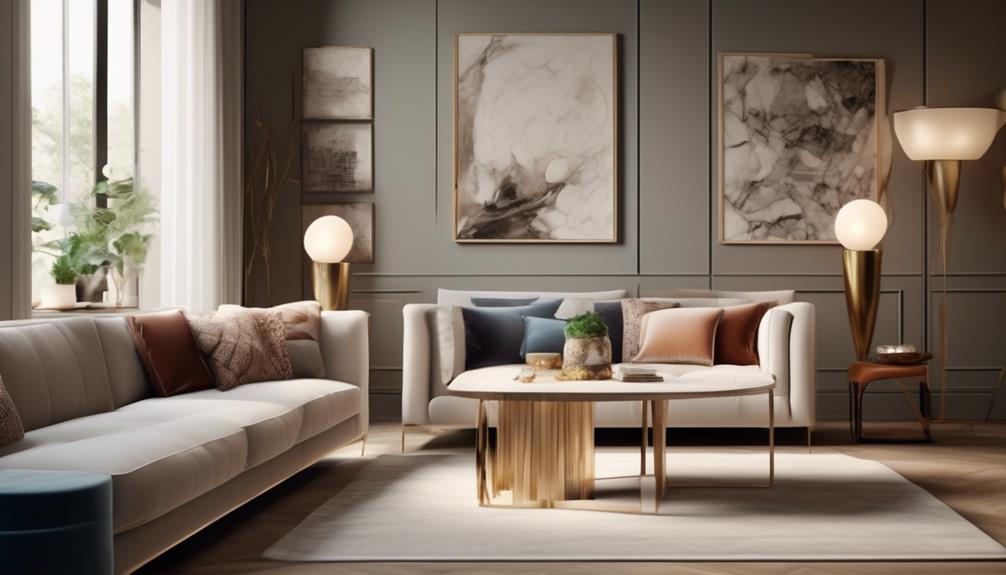
In our pursuit of arranging our living areas in the best possible way, we frequently consider the concept of positioning a table behind the couch. This smart setup provides many advantages, which has made it a favored option for many homeowners.
By utilizing this space-saving solution, we can maximize the functionality of our living areas without compromising on style. Not only does a table behind the sofa provide a convenient surface for drinks and snacks, but it also offers a functional storage option for books, magazines, or other items.
Additionally, it creates a visual focal point and enhances the aesthetic appeal of the room. Furthermore, this placement can effectively separate living and dining areas, adding a touch of elegance to our overall interior design.
Key Takeaways
- Maximizes functionality of living areas
- Provides convenient surface for drinks and snacks
- Offers functional storage option for books and magazines
- Reduces clutter in the living room
Space-Saving Solution
We discovered a space-saving solution that not only maximizes the functionality of a room but also adds a touch of elegance – the table behind the sofa. When it comes to furniture arrangement, this versatile design is a game-changer.
Gone are the days of wasting valuable floor space with bulky side tables or overcrowding the room with excessive furniture. The table behind the sofa provides a clever and practical alternative.
With its slim profile and sleek design, this table seamlessly blends into any living space. Placed against the back of the sofa, it takes advantage of the often overlooked area behind it. This allows for a more open and spacious feel in the room, making it perfect for smaller apartments or rooms with limited square footage.
The table behind the sofa not only saves space but also serves as a functional surface for various purposes. Whether you need a spot to place your coffee cup, display decorative items, or provide a convenient surface for lamps or books, this table has got you covered. Its versatile design makes it suitable for a range of different styles and aesthetics. From modern and minimalist to traditional and eclectic, the table behind the sofa effortlessly complements any interior design scheme.
In addition to its space-saving benefits, the table behind the sofa also adds a touch of elegance to the room. It serves as a visual anchor, creating a focal point that enhances the overall aesthetic appeal. The clean lines and sleek silhouette of the table contribute to a sophisticated and polished look.
With its practicality and style, this furniture arrangement solution truly embodies the essence of mastery in interior design.
Functional Storage Option

To maximize the functionality of your living space, consider the table behind the sofa as a functional storage option. Not only does it provide a stylish organization solution, but it also offers hidden compartments to keep your space neat and clutter-free. Here are four reasons why a table behind the sofa is a great storage option:
- Maximize Space: With limited square footage, it’s important to make the most of every inch. A table behind the sofa allows you to utilize the often-underutilized space behind your seating area.
- Convenient Storage: From remote controls and magazines to blankets and pillows, a table behind the sofa provides a convenient place to store everyday items. No more searching for misplaced items or cluttered surfaces.
- Hidden Compartments: Many tables behind the sofa come with hidden storage compartments. These compartments are perfect for storing items you want to keep out of sight, such as extra blankets or board games.
- Stylish Organization: A well-chosen table can add style and personality to your living room while also providing functional storage. Whether you prefer a modern, sleek design or a rustic, farmhouse look, there’s a table behind the sofa that will match your style and help you stay organized.
Displaying Decorative Items
When it comes to showcasing your personal style and adding a touch of elegance to your living room, the table behind the sofa offers the perfect platform for displaying decorative items. Not only does it serve as a functional storage option, but it also allows you to curate a visually appealing arrangement that reflects your taste and personality.
One way to utilize the table behind the sofa is by displaying artwork. Whether it’s a striking painting, a collection of framed photographs, or a sculptural piece, the table provides a visual backdrop that enhances the overall aesthetic of your living space. By strategically placing these artworks on the table, you can create a focal point that draws the eye and sparks conversation.
Another way to make use of the table is by organizing books. If you’re an avid reader or a collector of books, the table behind the sofa can serve as a stylish bookshelf. Stack your favorite novels, art books, or coffee table books neatly on the table, arranging them in an aesthetically pleasing manner. This not only adds visual interest but also makes your books easily accessible for a cozy reading session.
Convenient Surface for Drinks and Snacks

As we continue exploring the versatility of the table behind the sofa, let’s now turn our attention to its practical function as a convenient surface for drinks and snacks.
- Efficient Space Utilization: Placing a table behind the sofa allows us to make the most of our living room space. It provides a designated area for enjoying refreshments without the need for additional furniture.
- Convenient Accessibility: With a table behind the sofa, drinks and snacks are always within arm’s reach. No more awkwardly balancing plates or reaching for the coffee table across the room. Everything is right there, making entertaining or enjoying a movie night with friends effortless.
- Reduced Clutter: The table behind the sofa serves as a dedicated spot for drinks and snacks, preventing spills and messes on the upholstery. By keeping these items off the sofa, we maintain a clean and organized living space.
- Organizing Essentials: The table behind the sofa can also act as a hub for organizing essentials. We can use trays or baskets to neatly store coasters, napkins, and remote controls, ensuring everything we need is easily accessible.
Creating a Visual Focal Point
The table behind the sofa effortlessly commands attention, creating a captivating visual focal point in any living room. By placing a table behind the sofa, you not only provide a convenient surface for drinks and snacks, but also add color and create depth to your space.
Adding color to the table can instantly transform the look and feel of your living room. Consider choosing a table with a vibrant hue that complements your existing decor. Whether it’s a bold red or a soothing blue, the table can serve as a statement piece that draws the eye and adds visual interest to the room.
In addition to adding color, the table behind the sofa can also create depth in your living room. By placing a table with varying heights or incorporating shelves or drawers, you can introduce different levels and dimensions to the space. This not only adds visual intrigue but also allows you to display decorative items or store essentials, further enhancing the functionality of the table.
Enhancing the Aesthetic Appeal

Let’s explore the aesthetic benefits and functional purpose of having a table behind the sofa.
Not only does it add a stylish touch to the room, but it also serves as a practical solution for displaying decor, holding drinks, or even providing extra storage space.
The table behind the sofa can truly elevate the overall look and feel of your living space while serving a multitude of purposes.
Aesthetic Benefits
With a table behind the sofa, we can effortlessly elevate the aesthetic appeal of our living space. Here are four aesthetic benefits to consider:
- Design inspiration: Placing a table behind the sofa provides an opportunity to showcase our personal style and design preferences. We can adorn the table with decorative items such as vases, sculptures, or framed photographs that reflect our individuality and add visual interest to the room.
- Practical furniture placement: The table serves as a functional element, creating a visual separation between the sofa and the rest of the room. It acts as a transition piece, making the space feel more organized and inviting.
- Visual balance: The table behind the sofa can help create a sense of symmetry and balance in the room. By placing lamps or decorative objects on either side of the table, we can achieve a harmonious visual composition.
- Additional storage and display space: A table behind the sofa provides an opportunity to add extra storage or display options. We can choose a table with shelves or drawers to keep items like books, magazines, or remotes easily accessible, while also showcasing decorative objects on the tabletop.
Functional Purpose
Enhancing the aesthetic appeal, a table behind the sofa serves a functional purpose that effortlessly elevates the overall design of the living space.
Furniture placement is an art form, and the addition of a table behind the sofa creates a visually pleasing and well-balanced arrangement.
This versatile design element not only adds practicality but also enhances the style and character of the room.
The table provides a convenient surface for placing lamps, decorative items, or even a cup of coffee, making it a functional addition to the seating area.
Its presence adds depth and dimension to the space, creating a focal point that draws the eye and adds interest to an otherwise empty area.
Separating Living and Dining Areas
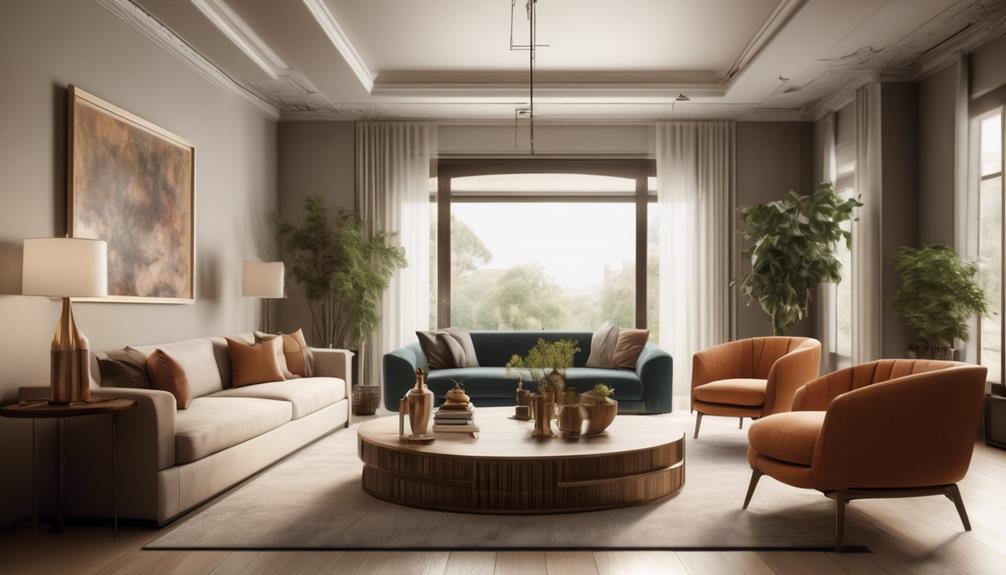
How can we effectively separate the living and dining areas in a stylish and functional way? Here are four ideas to consider:
- Use a room divider: A stylish and practical solution is to use a room divider to visually separate the living and dining areas. This can be a folding screen, a bookshelf, or even a curtain. Not only does it create a physical distinction, but it also adds an element of design to the space.
- Differentiate with lighting: Another way to separate the living and dining areas is by using different lighting fixtures. Install pendant lights or a chandelier above the dining table to create a focal point and define the dining space. In the living area, use floor or table lamps to create a cozy ambiance.
- Play with furniture placement: A strategic seating arrangement can effectively separate the living and dining areas. Position the sofa with its back facing the dining area, and place a console table behind it to act as a visual barrier. This not only creates distinct areas but also adds functionality by providing additional storage or display space.
- Utilize rugs and artwork: Use rugs to visually define the living and dining areas. Choose different patterns or colors to differentiate the spaces while maintaining a cohesive style. Hang artwork or mirrors on the walls to further emphasize the separation and add a touch of elegance to both areas.
Adding a Touch of Elegance

To elevate the aesthetic appeal of your living and dining areas, consider incorporating elements of sophistication and refinement. One effective way to achieve this is by adding elegant furniture to your space. When it comes to interior design, the right choice of furniture can make a significant difference. By placing an elegant table behind your sofa, you can create a focal point that adds a touch of elegance to your room.
An elegant table can serve multiple purposes. It can be used to display decorative items such as vases or sculptures, adding visual interest to the space. Additionally, it can also be used as a functional surface for placing drinks, books, or other items. This not only adds convenience but also adds a sense of sophistication to your living area.
When selecting an elegant table, consider the style and material that would best complement your existing furniture. Whether you opt for a sleek glass table or a classic wooden one, ensure that it harmonizes with the overall aesthetic of the room. By carefully considering the design and placement of your table, you can transform your living and dining areas into elegant spaces that exude refinement and style.
Maximizing the Functionality of Small Spaces

Now let’s explore the art of maximizing functionality in small spaces, where every inch counts and creativity is key. When it comes to small spaces, it’s essential to make the most out of every nook and cranny. Here are four ways to maximize storage and utilize multi-functional furniture to its full potential:
- Opt for furniture with built-in storage: Look for sofas, ottomans, and coffee tables that come with hidden compartments or drawers. These pieces not only serve their primary function but also provide additional storage space for items like blankets, books, or board games.
- Use vertical space: When floor space is limited, make use of your walls by installing shelves, floating cabinets, or hanging organizers. This allows you to store items without cluttering the room and gives a sense of verticality to your space.
- Invest in multi-functional furniture: Choose pieces that serve more than one purpose. For example, a desk that can also be used as a dining table or a sofa that can be transformed into a guest bed. This way, you can maximize the functionality of your furniture without sacrificing style or comfort.
- Utilize hidden storage solutions: Think outside the box and find clever ways to incorporate storage into unexpected places. Consider using storage ottomans, under-bed storage bins, or wall-mounted hooks to keep your belongings organized and out of sight.
Frequently Asked Questions
How to Choose the Right Size of a Table to Fit Behind a Sofa?
Choosing the right size table to fit behind a sofa is crucial for both functionality and style. To determine the perfect size, consider the length and height of the sofa. The table should be slightly shorter than the back of the sofa to avoid overpowering the space. Additionally, ensure that it’s narrow enough to allow for easy passage around the room.
Styling the table with decorative items or practical accessories can add a touch of elegance and functionality to your living area.
Can a Table Behind a Sofa Be Used as a Workspace or Home Office Area?
Using a table behind a sofa as a workspace or home office area can be a game-changer. Not only does it provide a dedicated and stylish space for productivity, but it also maximizes the use of available space.
One benefit is the convenience of having everything within arm’s reach. Additionally, organizing the area with desk organizers and cable management solutions can help create a clutter-free and efficient workspace.
With a table behind the sofa, you can have the best of both worlds – comfort and productivity.
What Are Some Creative Ways to Style the Table Behind a Sofa With Decorative Items?
When it comes to styling a narrow table behind a sofa, there are plenty of creative options to consider.
One idea is to use decorative items like vases, candles, or sculptures to add a touch of elegance to the space.
Another option is to incorporate a table behind a sectional sofa in your living room design by placing a stack of books, a statement lamp, or a small plant.
These styling tips can help you create a stylish and functional area in your home.
Are There Any Specific Types of Tables That Work Best Behind a Sofa?
When it comes to different furniture arrangements, there are specific types of tables that work best behind a sofa. Whether it’s a sleek console table or a rustic farmhouse-style table, the key is finding a table that complements the overall aesthetic of your space.
But don’t limit yourself to traditional uses! A table behind the sofa can serve as a mini bar, a workspace, or even a display area for your favorite artwork. The possibilities are endless!
How to Ensure the Table Behind the Sofa Doesn’t Obstruct the Flow of the Room?
To ensure the table behind the sofa doesn’t obstruct the flow of the room, there are a few design tips we can follow.
First, consider the size and shape of the table to ensure it fits properly. Opt for a slim and narrow table to maintain the flow.
Second, position the table parallel to the sofa, allowing easy access to both sides.
Lastly, utilize the table for storage and organization, maximizing its benefits in keeping the room clutter-free.
Can Placing a Table Behind My Sofa Help with Maneuvering It Upstairs?
Placing a table behind your sofa can make maneuvering it upstairs easier. By adding a table, you create a more stable surface for lifting and moving the sofa. This fit sofa upstairs discovery can make the process smoother and safer.
Conclusion
In conclusion, adding a table behind your sofa is a space-saving solution that offers functional storage and a convenient surface for drinks and snacks.
It also allows for the display of decorative items and creates a visual focal point, enhancing the aesthetic appeal of your living space.
With the ability to separate living and dining areas and add a touch of elegance, a sofa table maximizes the functionality of small spaces in an over-the-top, mind-blowing way!
- About the Author
- Latest Posts
Introducing Ron, the home decor aficionado at ByRetreat, whose passion for creating beautiful and inviting spaces is at the heart of his work. With his deep knowledge of home decor and his innate sense of style, Ron brings a wealth of expertise and a keen eye for detail to the ByRetreat team.
Ron’s love for home decor goes beyond aesthetics; he understands that our surroundings play a significant role in our overall well-being and productivity. With this in mind, Ron is dedicated to transforming remote workspaces into havens of comfort, functionality, and beauty.

Regarding bed bugs, it’s common to associate them with mattresses and bedding as their main spots for concealment. Yet, it’s vital to tackle a prevalent question: is it possible for a couch to harbor bed bugs?
We understand that you may be skeptical, but the truth is, bed bugs can infest couches just as easily as they can invade your bed.
In this article, we will delve into the factors that make couches attractive to these pesky pests, how to treat a couch infested with bed bugs, and most importantly, how to prevent them from making your couch their new home.
So let’s put those doubts to rest and explore the world of bed bugs in couches.
Key Takeaways
- Bed bugs can live in couches due to the hiding spots provided by the crevices and cushions.
- Infested couches can lead to bed bug bites and spread the infestation to other areas of the home.
- Regularly inspecting and cleaning couches can help prevent bed bug infestations.
- It is important to avoid bringing used furniture, including couches, into your home to prevent bed bug infestations.
The Basics of Bed Bugs
Bed bugs are small, parasitic insects that feed on the blood of humans and animals. Understanding bed bug behavior is crucial in effectively preventing infestations. These pests are nocturnal and prefer to hide in cracks and crevices during the day, making them difficult to detect. They can live for several months without feeding, allowing them to survive in various environments.
To prevent bed bug infestations, it’s essential to take proactive measures. Regularly inspecting your home, especially areas where bed bugs commonly hide, such as mattresses, furniture, and baseboards, can help identify an infestation early on. Additionally, washing and drying bedding, linens, and clothing at high temperatures can kill any bed bugs or eggs that may be present.
Using protective encasements for mattresses and box springs can help prevent bed bugs from infesting these areas. These encasements create a barrier, making it difficult for bed bugs to access the mattress or box spring. Vacuuming regularly and disposing of the vacuum bag in a sealed plastic bag can also help remove any bed bugs or eggs that may be present.
Understanding Bed Bug Infestations

Now let’s delve into the topic of understanding bed bug infestations.
When it comes to identifying an infestation, there are several key signs to look out for. These include the presence of live bugs, eggs, or dark brown stains on bedding or furniture.
Treatment options for bed bug infestations can vary. Commonly, they include professional extermination, heat treatments, or the use of insecticides.
Signs of Infestation
Upon detecting the presence of bed bugs, it is imperative to familiarize ourselves with the signs of infestation in order to effectively address and eradicate the problem. Bed bug infestations can be easily identified through various indicators. Here are some common signs to look out for:
Signs of Infestation Rusty or reddish stains on bed sheets or mattresses Dark spots (bed bug excrement) on furniture or walls Sweet, musty odor Live bed bugs or discarded exoskeletons
These signs are crucial for early detection and prompt action. It is also essential to understand that bed bug bites can be mistaken for other insect bites or skin conditions. If you suspect bed bugs, it is recommended to consult a healthcare professional for accurate diagnosis of bed bug bites. Additionally, adopting bed bug prevention tips such as regularly inspecting and cleaning furniture, using mattress encasements, and minimizing clutter can help mitigate the risk of infestation.
Treatment Options
To effectively address and eradicate a bed bug infestation, it’s crucial to understand the treatment options available while gaining a comprehensive understanding of bed bug infestations.
When it comes to treating a bed bug infestation, there are several treatment options to consider. One common treatment method is the application of insecticides, which can be used to target and kill the bugs.
Heat treatments are also effective, as bed bugs can’t survive in temperatures above 120 degrees Fahrenheit. Another option is the use of steam, which can kill bed bugs and their eggs on contact.
In addition to these treatment options, it’s important to implement prevention techniques to avoid re-infestation. This includes regularly cleaning and vacuuming the area, sealing cracks and crevices, and using mattress encasements to prevent bed bugs from infesting your sleeping area.
Signs of Bed Bugs in Your Home
If you suspect the presence of bed bugs in your home, there are several telltale signs to look out for:
- Bloodstains on your sheets or pillowcases: Bed bugs feed on human blood, so you may find small reddish-brown stains on your bedding as a result of their feeding activity.
- Dark spots on your mattress or furniture: Bed bugs leave behind fecal stains, which are dark in color and can be found on your mattress, furniture, or walls.
- Eggshells or shed skins: As bed bugs go through their life cycle, they shed their skin multiple times. Look for these translucent shells or the shed skins in areas where bed bugs are likely to hide.
- Musty odor: Bed bugs release pheromones, which can result in a distinctive musty odor. If you notice an unpleasant smell in your bedroom, it could be an indication of a bed bug infestation.
- Visible bed bugs: In severe infestations, you may see the actual bed bugs themselves. These small, flat, reddish-brown insects can be found in the seams of your mattress, behind headboards, or in cracks and crevices near your sleeping area.
If you find any of these signs, it’s important to take immediate action to address the infestation. DIY bed bug treatment methods, such as vacuuming, steaming, and using bed bug sprays, can help eliminate the pests.
However, prevention is key to avoiding future infestations. Regularly inspect your bedding and furniture, use protective mattress covers, and avoid bringing used furniture into your home to prevent bed bug infestations in your home.
Can Bed Bugs Live in Couches?

Yes, bed bugs can indeed live in couches. Couches provide an ideal hiding spot for these pests, with their crevices and cushioned areas offering ample space for them to nest.
Treating couch bed bugs requires a thorough approach, including vacuuming, steam cleaning, and using insecticides specifically designed for bed bug infestations.
Couch Infestations
Bed bugs are capable of living and infesting couches, making them a potential hiding place for these pests within a home. To prevent couch infestation and identify couch bed bug eggs, consider the following:
- Regularly inspect your couch for any signs of bed bug activity, such as dark stains or shed skins.
- Use a flashlight to check the crevices, seams, and folds of your couch where bed bugs might hide.
- Vacuum your couch thoroughly, paying close attention to the areas where bed bugs are likely to reside.
Encase your couch in a bed bug-proof cover to prevent infestation and trap any existing bed bugs.
If you suspect a couch infestation, contact a professional pest control company for effective treatment options.
Hiding Spots in Couches
Bed bugs have the ability to inhabit and hide in various locations within couches. These sneaky pests are experts at finding tiny crevices and hiding spots where they can go unnoticed.
Common hiding spots in couches include seams, cushions, and even inside the frame. The narrow spaces between the cushions and the frame provide the perfect shelter for these nocturnal insects.
It’s important to note that bed bugs can also infest other furniture pieces such as chairs and recliners. If you suspect a bed bug infestation in your couch, it’s crucial to take immediate action.
Professional extermination is often necessary to completely eliminate these resilient pests. Additionally, thorough couch cleaning, including vacuuming and steam cleaning, can help to remove any remaining bed bugs or eggs.
Treating Couch Bed Bugs
Treatment for couch bed bugs involves a comprehensive approach to eliminate these resilient pests from their hiding spots within the couch. To effectively treat couch infestations and prevent future infestations, consider the following steps:
- Inspection: Thoroughly examine the couch, including seams, cushions, and cracks, to identify the extent of the infestation.
- Vacuuming: Use a vacuum cleaner with a HEPA filter to remove bed bugs and their eggs from the couch.
- Steam Cleaning: Steam clean the entire couch, focusing on areas where bed bugs are likely to hide.
- Chemical Treatment: Apply bed bug insecticides to targeted areas, following the product instructions carefully.
- Encasements: Cover the couch with bed bug-proof encasements to prevent re-infestation.
Factors That Make Couches Attractive to Bed Bugs
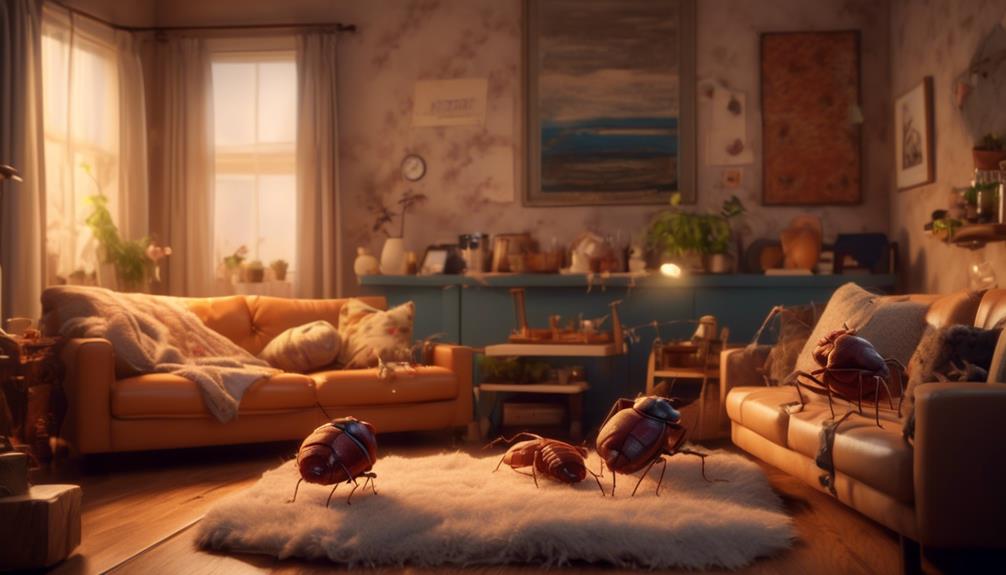
Couches can be particularly appealing to bed bugs due to various factors. Bed bugs are attracted to warmth, and couches provide the ideal environment for them to thrive. The upholstery and padding of couches offer numerous hiding places for bed bugs, allowing them to remain undetected and reproduce rapidly. Additionally, the crevices and seams of couches provide perfect hiding spots for these pests.
Factors influencing bed bug infestations in couches include the presence of other infested furniture or bedding in the vicinity. Bed bugs can easily spread from one piece of furniture to another, so if there’s already an infestation in the home, it’s likely that the couch will become infested as well. Furthermore, factors such as a cluttered environment or a lack of regular cleaning can make couches even more attractive to bed bugs.
Prevention tips for keeping couches bed bug-free include regularly vacuuming and steam cleaning the couch to eliminate any potential hiding places. It’s also important to inspect and treat any infested furniture or bedding promptly to prevent the infestation from spreading. Additionally, using mattress and couch encasements can help protect against bed bugs by creating a barrier that they can’t penetrate.
How Bed Bugs Get Into Couches

After understanding the factors that make couches attractive to bed bugs, it’s important to explore how these pests actually get into couches.
Bed bugs are notorious for their ability to infest various areas of our homes, including couches. Here are some ways that bed bugs can find their way into your cozy couch:
- Hitchhiking: Bed bugs are excellent hitchhikers and can easily latch onto clothing, bags, or even pets, making their way into your couch when you bring them inside your home.
- Infested furniture: If you bring in used furniture, especially mattresses or couches, that are already infested with bed bugs, they can quickly spread to other areas of your home, including your couch.
- Clutter: A cluttered couch provides the perfect hiding spot for bed bugs. They can easily crawl into the crevices and seams, making it difficult for you to spot them.
- Nearby infestations: If there are other areas in your home that are already infested with bed bugs, they can easily migrate to your couch, seeking a new hiding spot.
- Travel: If you have recently stayed in a hotel or visited a place with a bed bug infestation, there’s a chance that you unintentionally brought them home with you, and they may end up in your couch.
Knowing how bed bugs can get into your couch is essential in preventing infestations and protecting your home. By being aware of these factors, you can take the necessary steps to keep these unwanted pests at bay.
Can Bed Bugs Survive on Couches Without Humans?

Bed bugs are capable of surviving on couches even in the absence of humans. Factors influencing bed bug survival on couches without humans include temperature, humidity, and the availability of other potential hosts or food sources.
Couches, along with beds, are one of the most common places where bed bugs infest. These insects can easily hide within the crevices and seams of couches, making them an ideal secondary infestation site. If a couch is infested, bed bugs can survive by feeding on other animals, such as pets or rodents, that may come into contact with the couch. Additionally, they can go into a state of hibernation or enter a dormant phase, allowing them to survive for several months without feeding.
However, it’s important to note that bed bugs are primarily attracted to the presence of humans. Without a readily available source of blood, their population and infestation levels on couches may decline over time. Nonetheless, it’s still possible for bed bugs to survive on couches without humans, especially if the conditions are favorable for their survival.
To prevent bed bug infestations on couches, it’s crucial to regularly inspect and clean them. Vacuuming the upholstery, washing the covers in hot water, and using bed bug-proof encasements can help eliminate or prevent infestations. It’s also recommended to seek professional pest control assistance to eradicate bed bugs effectively.
How to Check Your Couch for Bed Bugs
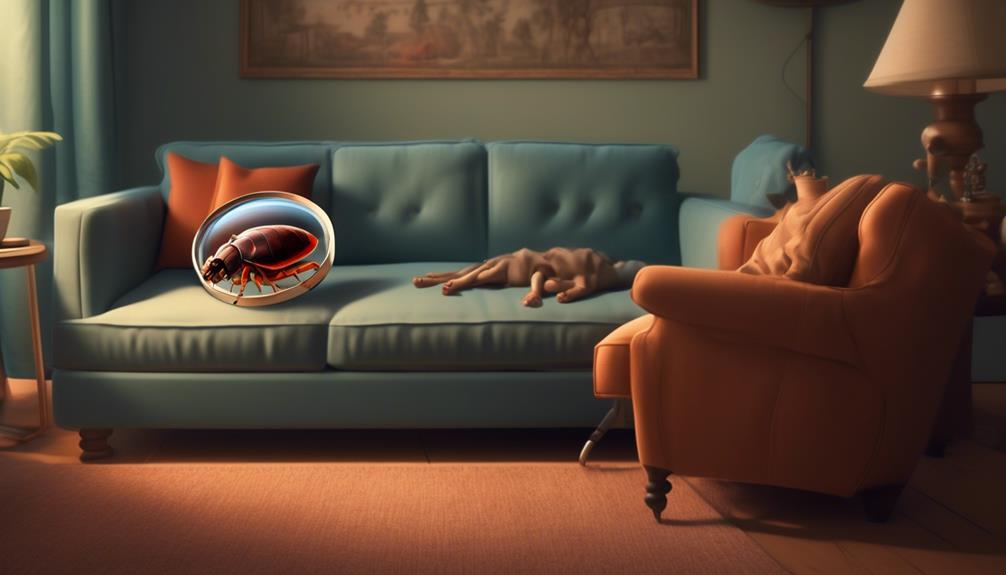
Now let’s talk about how to check your couch for bed bugs.
There are a few key signs of infestation to look out for, such as:
- Dark stains or spots on the fabric
- Discarded exoskeletons
- A musty odor
Bed bugs often hide in common spots like:
- Seams
- Crevices
- Underneath cushions
So be sure to thoroughly inspect these areas.
To conduct a DIY inspection, use a flashlight to carefully examine the entire couch, paying close attention to any potential hiding spots.
Signs of Infestation
To effectively check your couch for bed bugs, it’s important to be aware of the signs of infestation. Here are some common signs to look out for during your DIY inspection:
- Blood stains or dark spots on the fabric: These could be the result of bed bugs being crushed or their excrement.
- Musty odor: Bed bugs release a distinct smell that’s often described as musty or sweet.
- Shed skins and eggshells: As bed bugs grow, they molt and leave behind their old skins and eggshells.
- Live bed bugs: Adult bed bugs are small, oval-shaped, and reddish-brown in color. Look for them in the seams, crevices, and folds of your couch.
- Red, itchy bites: Bed bug bites often appear in a cluster or a line on exposed skin.
Common Hiding Spots
One common hiding spot for bed bugs in your couch is the seams and crevices. These tiny pests can easily squeeze into the narrow spaces between the cushions, where they can lay their eggs and thrive undisturbed.
To check for bed bugs in your couch, start by examining the seams and crevices with a flashlight. Look for any signs of bed bug activity, such as live bugs, shed skins, or dark stains, which are fecal spots left behind by the bugs.
If you suspect an infestation, it’s important to act quickly. Vacuum the couch thoroughly, paying close attention to the seams and crevices. Use a stiff brush to dislodge any eggs or bugs.
Consider using a mattress encasement to prevent future infestations. Regularly inspect and clean your couch to keep it free from bed bugs.
DIY Inspection Methods
Are you wondering how to effectively inspect your couch for bed bugs? Don’t worry, we’ve got you covered! Here are some DIY inspection techniques you can use to ensure your couch is free from these pesky pests:
- Visual Inspection: Start by carefully examining your couch, paying close attention to seams, crevices, and any dark spots.
- Use a Flashlight: Shed some light on the situation by using a flashlight to search for signs of couch infestations, such as tiny black spots or shed exoskeletons.
- Inspect Upholstery: Remove cushions and thoroughly inspect the upholstery, looking for any signs of bed bugs or their eggs.
- Check for Stains: Bed bugs leave behind dark stains, so be on the lookout for any discolored areas on your couch.
- Monitor for Bites: If you or your family members wake up with unexplained bites, it’s time to inspect your couch for bed bugs.
Treating a Couch Infested With Bed Bugs

When dealing with a couch infested with bed bugs, it’s crucial to apply a comprehensive treatment approach to effectively eradicate these pests. Treating couch infestations requires a combination of methods to ensure complete elimination.
The first step is to thoroughly vacuum the entire couch, paying close attention to seams, cushions, and crevices. This helps remove any live bugs, eggs, or fecal matter.
After vacuuming, it’s important to steam clean the couch using high temperatures, as bed bugs can’t survive extreme heat. This kills any remaining bugs and their eggs.
Additionally, washing and drying all removable cushions, covers, and blankets on high heat can help eliminate any hidden bed bugs.
To prevent future infestations, it’s crucial to regularly inspect and vacuum the couch, especially in areas where bed bugs are commonly found, such as between cushions and along seams. Using mattress encasements and interceptors can also act as a preventive measure, trapping any bed bugs that may try to infest the couch.
Preventing Bed Bugs in Your Couch

To prevent bed bugs from infesting your couch, regularly inspect and vacuum all areas, paying close attention to seams and crevices. Bed bugs can easily hide in these areas and quickly infest your couch if not properly cleaned and maintained.
Here are some effective cleaning methods to prevent infestation:
- Encase your couch in a bed bug-proof cover. This will prevent any existing bed bugs from escaping and new ones from entering.
- Use a steam cleaner on your couch regularly. The high temperature of the steam will kill any bed bugs and their eggs.
- Wash and dry all removable upholstery covers on a high heat setting. This will eliminate any bed bugs that may be hiding in the fabric.
- Vacuum your couch thoroughly, using a brush attachment to reach into the seams and crevices. Empty the vacuum bag or canister into a sealed plastic bag and dispose of it immediately.
- Keep your couch clutter-free. Remove any unnecessary items or debris that may provide hiding spots for bed bugs.
Bed Bug Myths and Misconceptions

After learning how to prevent bed bugs from infesting your couch, it’s important to debunk common myths and misconceptions surrounding these pests. Bed bug misconceptions can lead to unnecessary anxiety and incorrect actions when it comes to dealing with infestations.
One common myth is that bed bugs only infest dirty or unkempt homes. In reality, bed bugs can infest any home, regardless of its cleanliness.
Another myth is that bed bugs are only found in beds. While they’re commonly found in mattresses and bedding, bed bugs can also infest other furniture, such as couches and chairs. It’s important to thoroughly inspect all furniture, not just beds, if you suspect a bed bug infestation.
Additionally, some people believe that bed bugs are too small to see with the naked eye. While they’re small, adult bed bugs can be visible to the naked eye and are about the size of an apple seed.
Debunking these myths and misconceptions is crucial in order to effectively address and eliminate bed bug infestations.
Conclusion: Keeping Your Couch Bed Bug-Free

The essential steps to maintain a bed bug-free couch involve regular inspections, proper cleaning, and vigilant prevention measures. By following these recommendations, you can ensure that your couch remains a safe and comfortable place to relax.
To keep your couch clean and bed bug-free, consider the following:
- Inspect your couch regularly: Look for signs of bed bugs such as dark spots, shed skins, or live bugs. Pay attention to crevices, seams, and the underside of cushions.
- Vacuum your couch regularly: Use a vacuum cleaner with a brush attachment to thoroughly clean all surfaces of your couch, including the cushions and crevices where bed bugs may hide.
- Wash removable covers and linens: If your couch has removable covers or linens, wash them regularly in hot water to kill any bed bugs or eggs that may be present.
- Use mattress and pillow encasements: Consider using encasements specifically designed to protect your couch from bed bugs. These encasements can prevent bed bugs from infesting your couch and make it easier to spot and eliminate any potential infestations.
- Consider hiring professionals: If you suspect a bed bug infestation on your couch, it may be necessary to seek professional help. Pest control professionals have the expertise and tools to effectively remove bed bugs from your couch and prevent future infestations.
Frequently Asked Questions
How Long Do Bed Bugs Typically Survive Without a Human Host in a Couch?
Bed bugs can survive for several months without a human host, depending on environmental factors. Their survival rate is influenced by temperature, humidity, and access to food sources. However, it’s important to note that bed bugs can’t reproduce solely in a couch environment.
While they may temporarily infest a couch, they require human blood to lay eggs and continue their life cycle. Regular cleaning and inspection are crucial to prevent and address any potential couch infestations.
Can Bed Bugs Infest Only Certain Types of Couches?
Yes, a couch can indeed have bed bugs. It’s important to note that bed bugs aren’t picky when it comes to infesting furniture. They can easily make themselves at home in all types of couches, from leather to fabric.
To prevent couch infestation, it’s crucial to regularly inspect and clean your couch, including vacuuming all crevices and seams. Additionally, using bed bug-proof encasements and regularly washing or drying your couch covers on high heat can help prevent these pesky pests from taking up residence in your couch.
Are There Any Natural Remedies to Get Rid of Bed Bugs in a Couch?
When it comes to dealing with bed bugs in a couch, many people wonder if there are any natural remedies available.
Well, let me tell you, there are indeed some effective home remedies that can help get rid of these pesky creatures.
From using diatomaceous earth to steam cleaning, there are several methods you can try.
However, it’s important to note that the effectiveness of these natural remedies may vary depending on the severity of the infestation.
Can Bed Bugs Migrate From a Couch to Other Furniture in the House?
Bed bugs can spread from a couch to mattresses, as they’re skilled hitchhikers. They can survive in other household items besides furniture, such as bedding, curtains, and even clothing.
It’s important to thoroughly inspect and treat all potentially infested areas to prevent further spread. Regularly vacuuming and washing bedding in hot water can help eliminate these pests.
How Often Should a Couch Be Inspected for Bed Bugs?
Regular couch inspections are crucial to prevent and detect bed bug infestations. By examining the seams, cushions, and crevices, we can identify signs of these pesky critters. Look for dark spots, shed skin, and tiny eggs. Additionally, keep an eye out for live bugs or their excrement.
It’s recommended to inspect your couch at least once a month, especially if you’ve recently traveled or had guests over. Prompt action can help us tackle these unwelcome guests before they spread to other furniture in the house.
Can Bed Bugs Infest a Cat-Proof Sofa?
Looking for the best sofa for cat owners? Wondering if bed bugs can infest a cat-proof sofa? While cat-proof sofas can help protect against scratching and accidents, they are not necessarily immune to bed bug infestations. It’s always best to take precautions and regularly inspect your furniture for any signs of pests.
Conclusion
In conclusion, it’s crucial to take preventive measures to keep your couch free from bed bugs.
Regularly inspect and clean your couch, especially the seams and crevices where bed bugs can hide.
Remember, ‘An ounce of prevention is worth a pound of cure.’
By being proactive and addressing any signs of bed bugs early on, you can ensure a bed bug-free couch and a comfortable living space.
- About the Author
- Latest Posts
Introducing Ron, the home decor aficionado at ByRetreat, whose passion for creating beautiful and inviting spaces is at the heart of his work. With his deep knowledge of home decor and his innate sense of style, Ron brings a wealth of expertise and a keen eye for detail to the ByRetreat team.
Ron’s love for home decor goes beyond aesthetics; he understands that our surroundings play a significant role in our overall well-being and productivity. With this in mind, Ron is dedicated to transforming remote workspaces into havens of comfort, functionality, and beauty.
-

 Vetted3 weeks ago
Vetted3 weeks ago15 Best Drip Irrigation Systems to Keep Your Garden Thriving
-

 Vetted2 days ago
Vetted2 days ago15 Best Foot Massagers for Neuropathy to Soothe Your Feet and Relieve Discomfort
-

 Vetted1 week ago
Vetted1 week ago15 Best Sports Laundry Detergents for Keeping Your Activewear Fresh and Clean
-
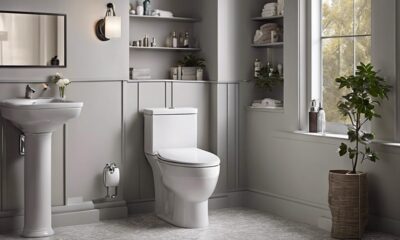
 Vetted1 week ago
Vetted1 week ago15 Best Tall Toilets for Seniors That Combine Comfort and Safety
-

 Vetted2 weeks ago
Vetted2 weeks ago15 Best Dish Scrubbers to Keep Your Kitchen Sparkling Clean
-

 Beginners Guides4 weeks ago
Beginners Guides4 weeks agoDesigning Your Retreat Center – Essential Tips
-
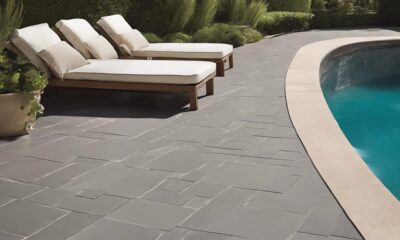
 Vetted4 weeks ago
Vetted4 weeks ago15 Best Tile Adhesives for Outdoor Use – Top Picks for Durable and Weather-Resistant Installations
-

 Beginners Guides4 weeks ago
Beginners Guides4 weeks agoAre Retreats Profitable





